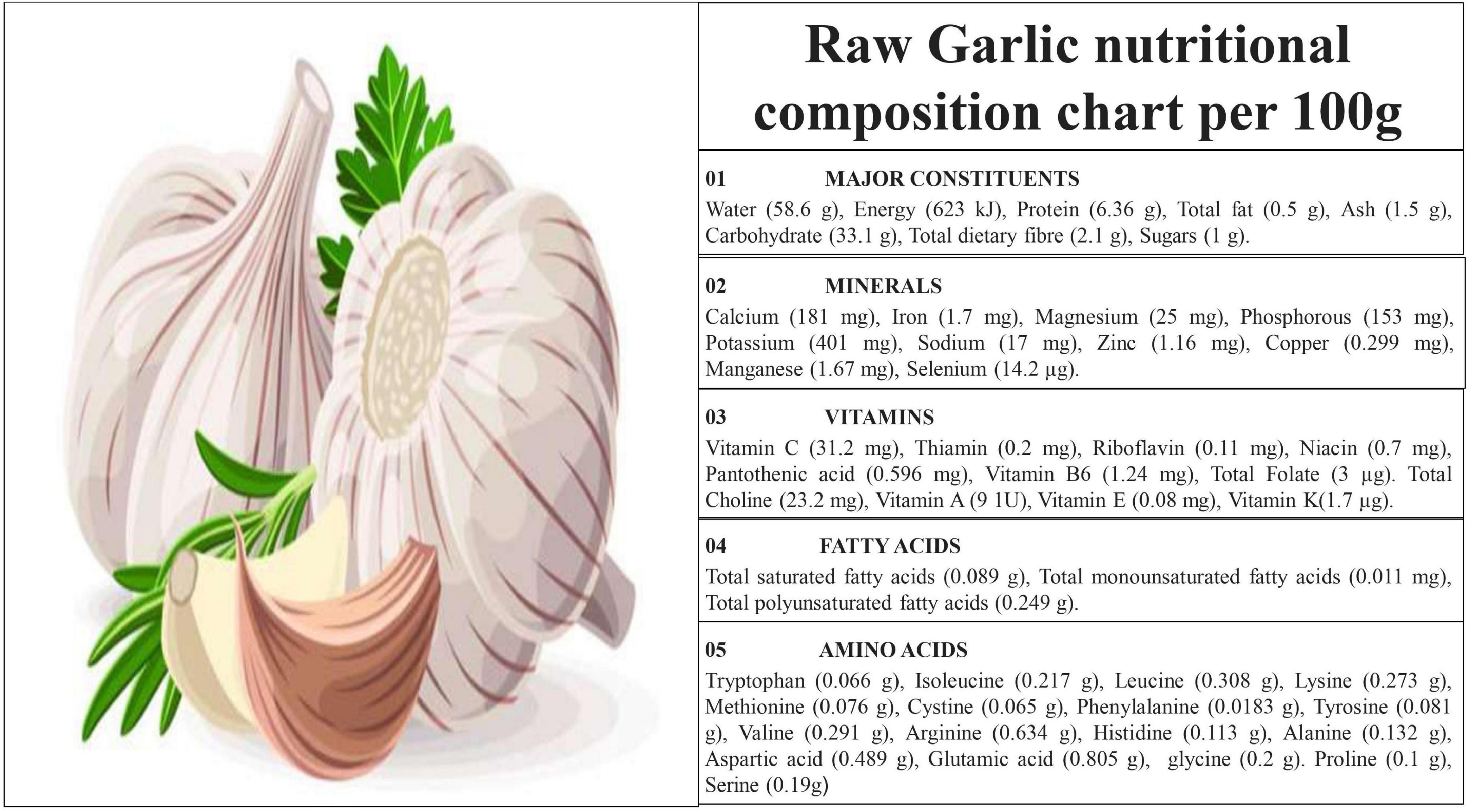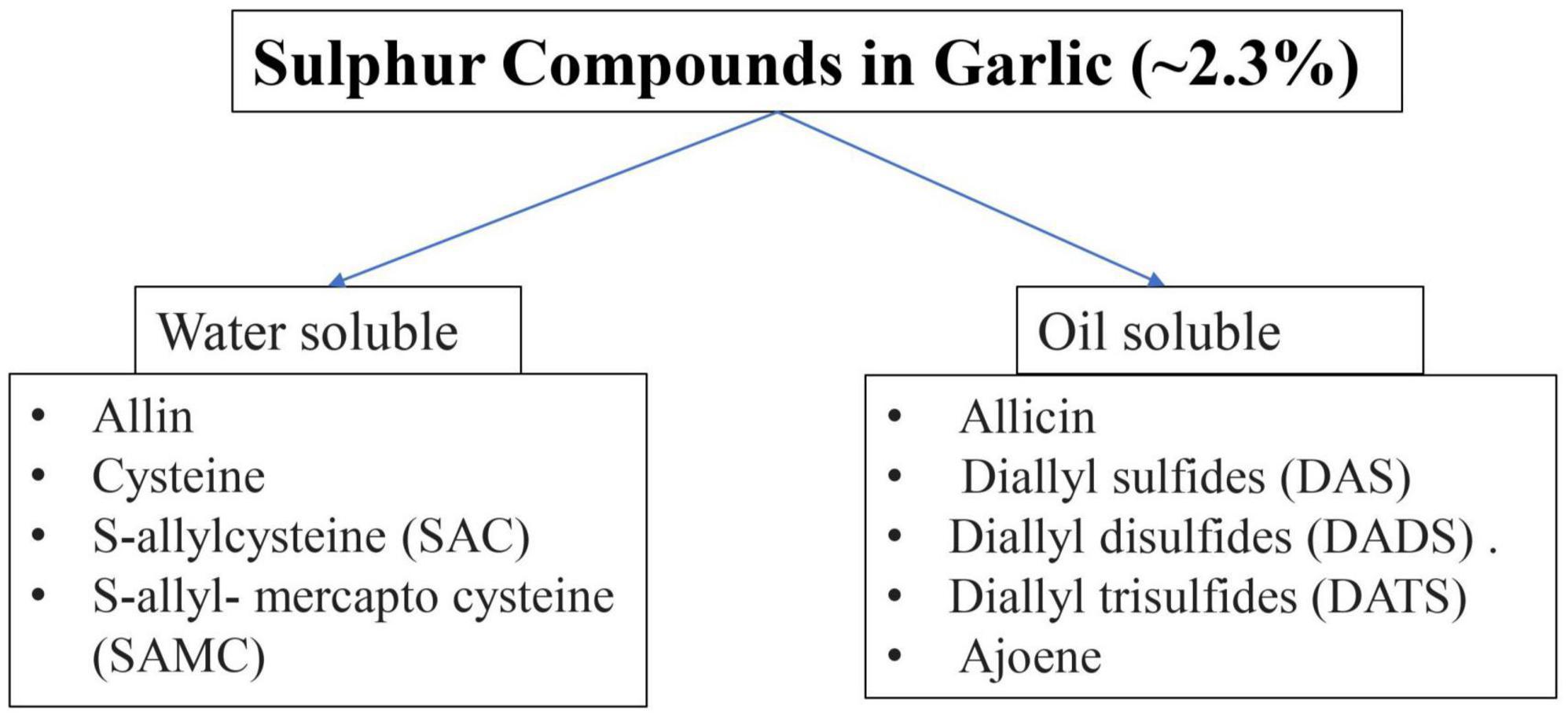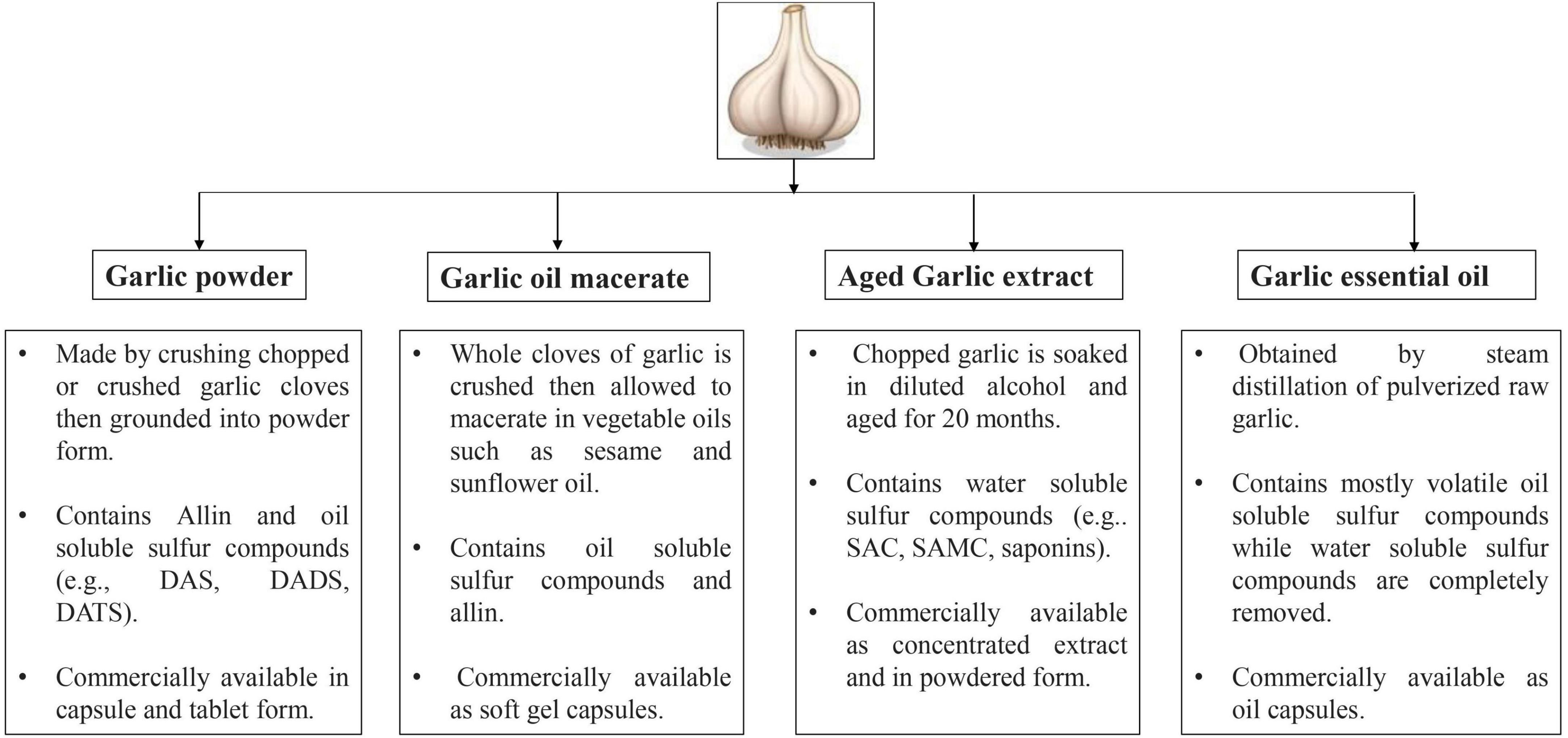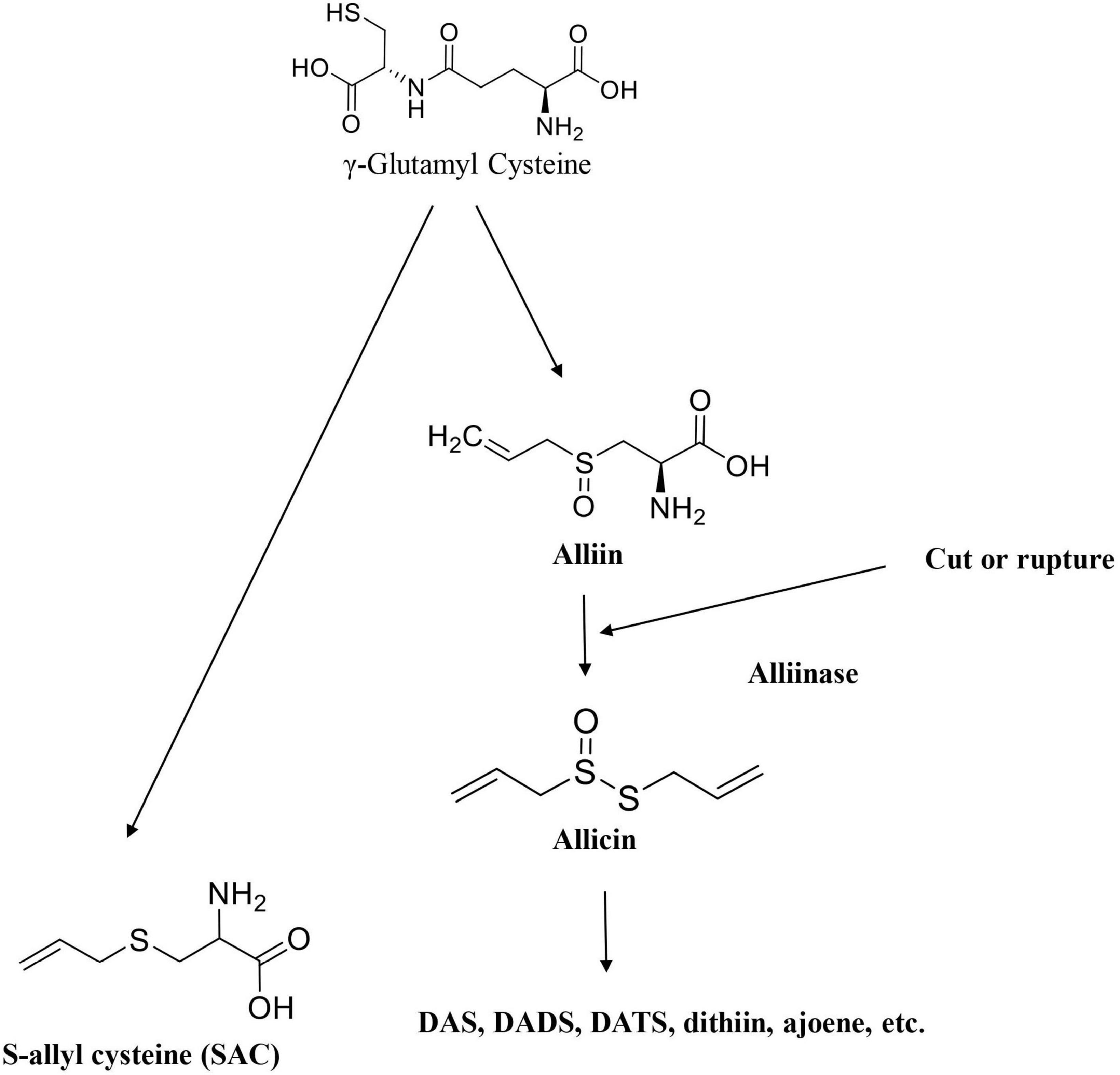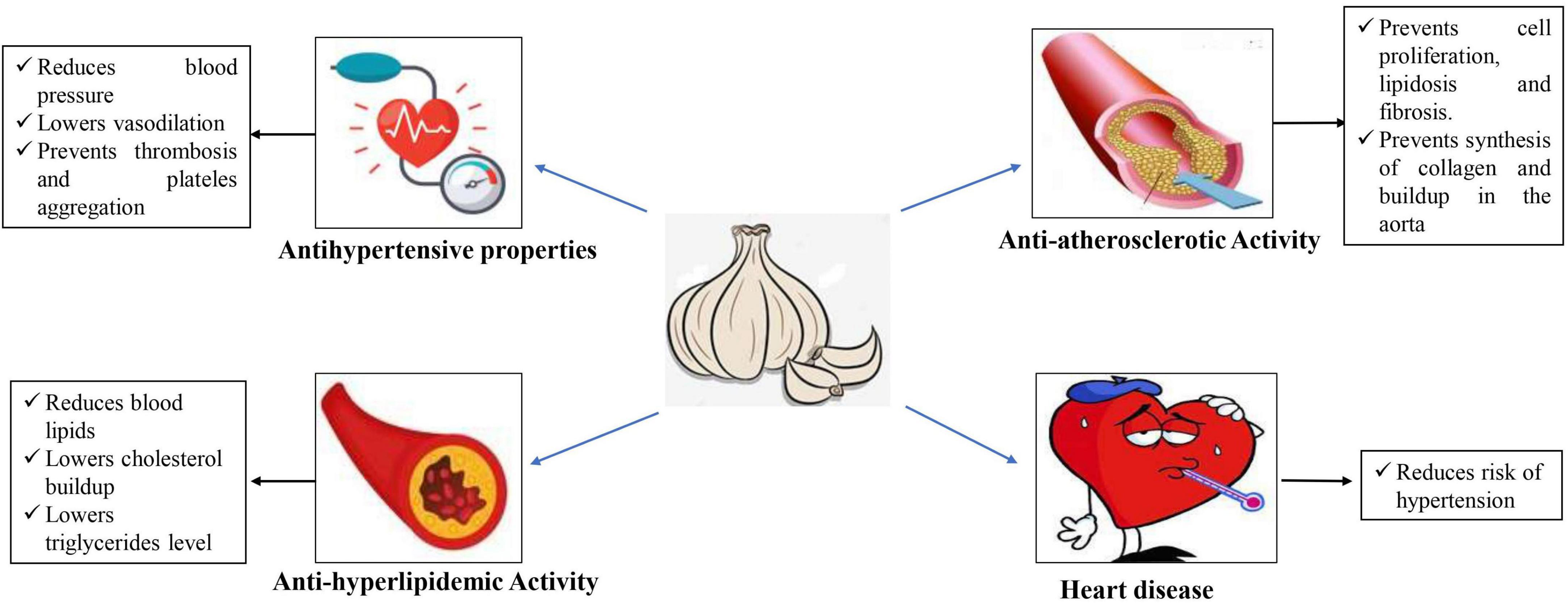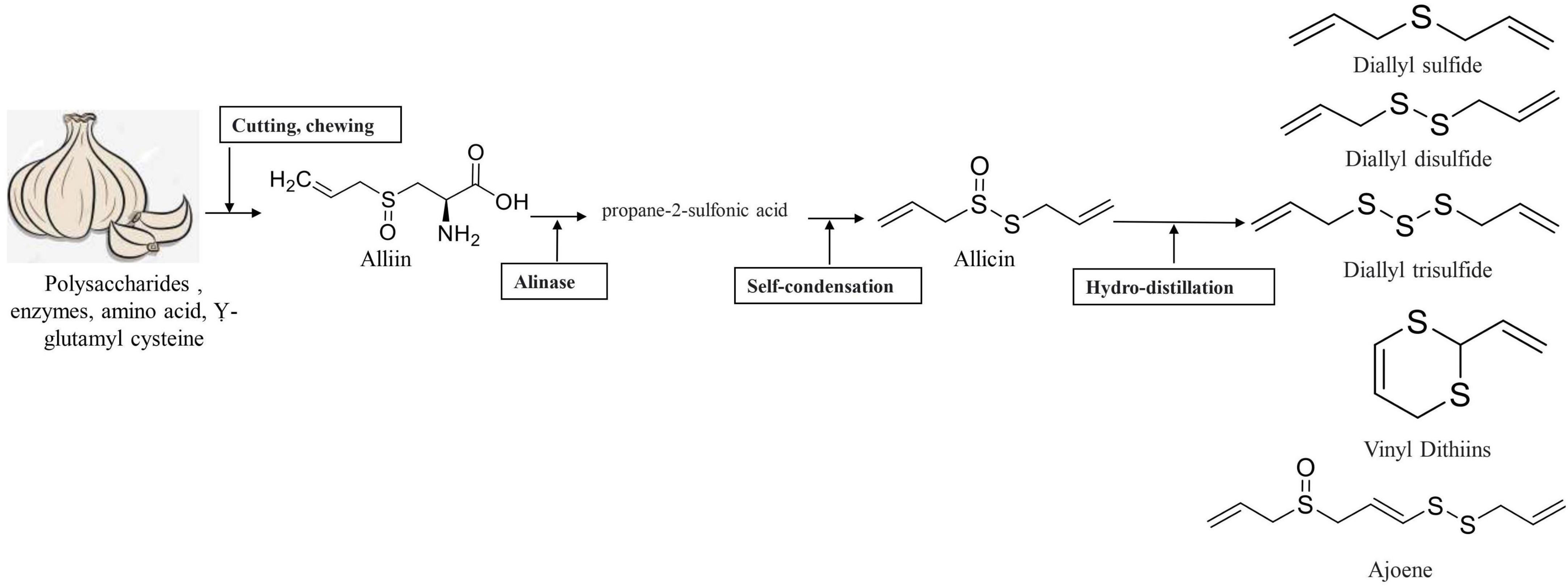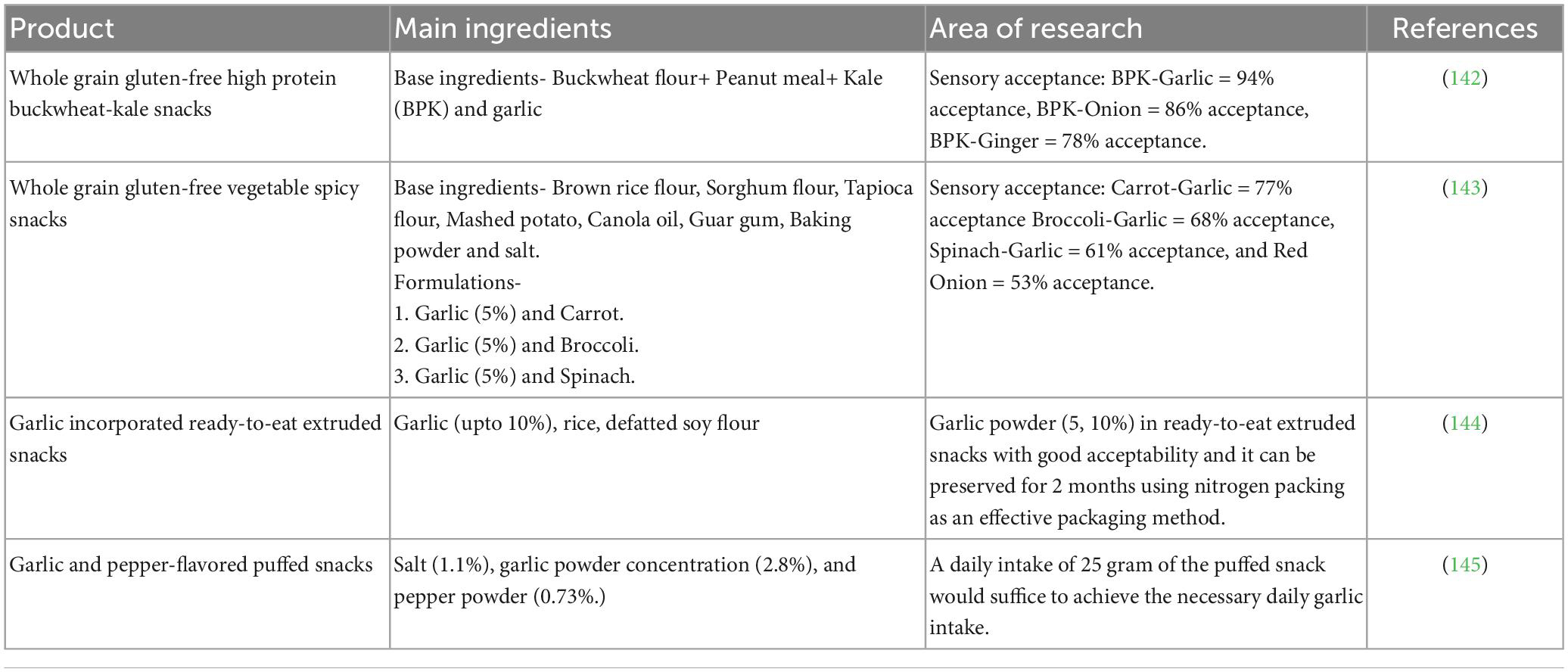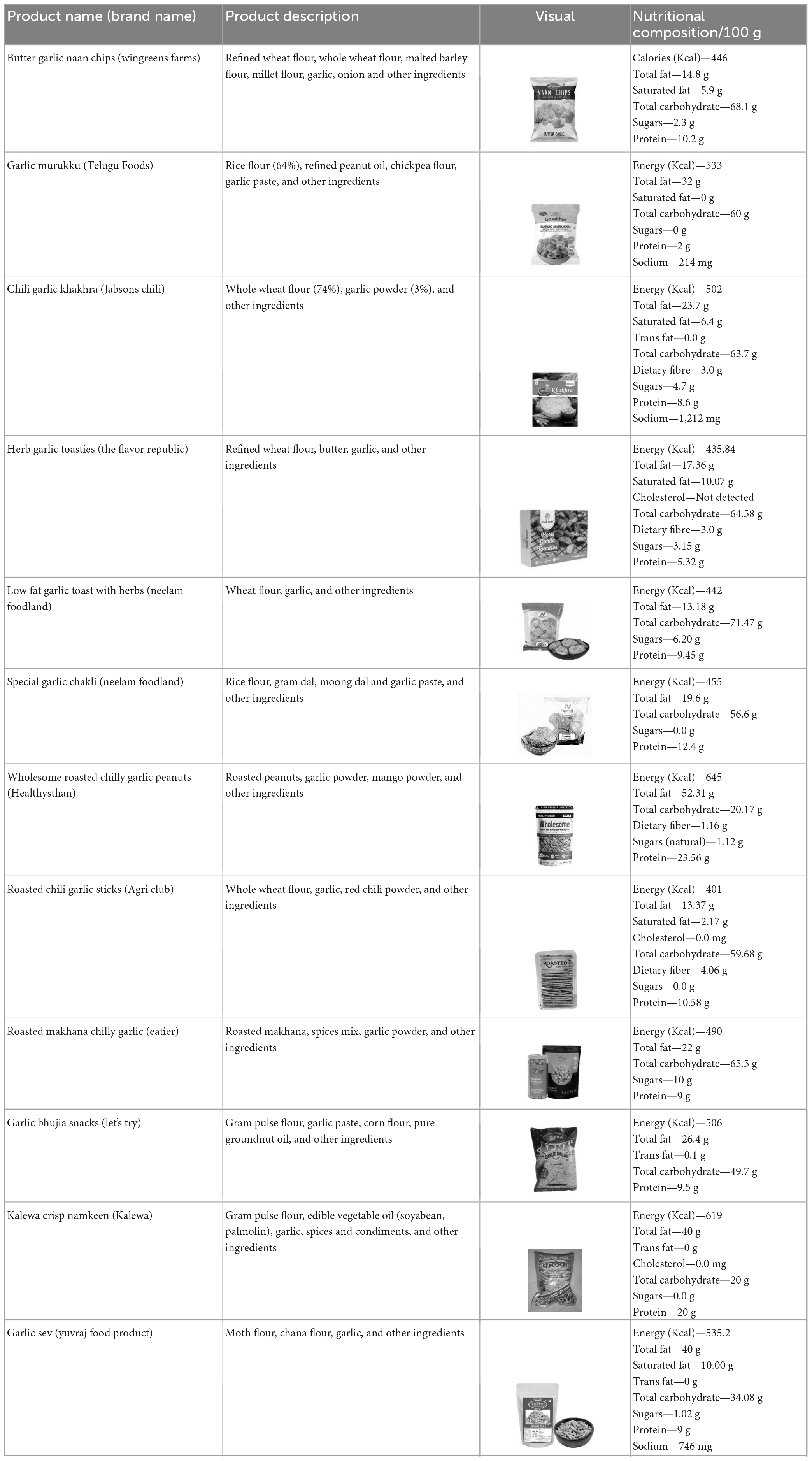- 1Department of Dairy Science and Food Technology, Institute of Agricultural Sciences, Banaras Hindu University, Varanasi, Uttar Pradesh, India
- 2Department of Pharmacology and Toxicology, College of Pharmacy, Prince Sattam Bin Abdulaziz University, Al-Kharj, Saudi Arabia
- 3Department of Occupational Medicine, Tainan Municipal Hospital (Managed by Show Chwan Medical Care Corporation), Tainan, Taiwan
- 4Department of Public Health, College of Medicine, National Cheng Kung University, Tainan, Taiwan
- 5Department of Rasa Shastra and Bhaishajya Kalpana, Faculty of Ayurveda, Institute of Medical Sciences, Banaras Hindu University, Varanasi, Uttar Pradesh, India
Garlic (Allium sativum) is an edible tuber belonging to the family Liliaceae. It has been used since ancient times as a spice to enhance the sensory characteristics of food and as a household remedy for the treatment of a variety of ailments. Garlic has been studied for its medicinal and therapeutic effects in the treatment of various human diseases for a long time. Health benefits associated with the consumption of garlic are attributed to the various sulfur compounds present in it such as allicin, ajoene, vinyl-dithiin, and other volatile organosulfur compounds which are all metabolized from alliin. Several researches in the literature have shown evidence that garlic exhibits antioxidant, antiviral, anti-microbial, anti-fungal, antihypertensive, anti-anemic, anti-hyperlipidemic, anticarcinogenic, antiaggregant, and immunomodulatory properties. The present review identifies and discusses the various health benefits associated with the consumption of garlic, its essential oil, and bioactive constituents, along with exploring the various snack-food products developed by incorporating garlic.
1. Introduction
Urbanization has brought many changes in society worldwide which includes consumers’ lifestyles and as a result their dietary practices. Snacks have become a quick and convenient food option for consumers. People are increasingly snacking in between main meals, originally to alleviate hunger but subsequently as a mainstream meal. According to Renub Research (1) latest report India’s snack food industry consists of many Indian as well as multinational companies. The market of snack food products in India is valued at US$ 11.08 Billion in 2020 and is expected to expand with a double-digit compound annual growth rate (CAGR) of 13.24% from 2020 to 2026 (1). Indian snacks market is categorized into Chips, Extruded Snacks, Namkeen, and others in which namkeen has the highest market value share in comparison to all other segments. Namkeen is currently the dominating category in both organized and unorganized markets in which fast-moving consumer goods (FMCG) companies capture a large market for its snacks segment. However, with the arrival of nutritional snacks enriched with organic ingredients with low calorie/oil content into the Indian market, these snacks are considered a bit healthier than conventional snacks and so are preferred by a large Indian population (1). Rising consumer health awareness is increasing the adoption of value-added product alternatives with natural, organic, low-calorie, vegan, gluten-free ingredients and components which imparts functional properties. With an increase in lifestyle ailments such as diabetes and cardiovascular disease, customers want to purchase products that are not only delicious and readily available, but nutritious as well.
Herbs and spices could be useful as a functional and flavoring ingredient as well as pharmacological and therapeutic properties in snack products (2). Garlic (Allium sativum L.; Liliaceae family) is one of the most important bulb crops which is grown and used as a spice and a popular Indian traditional medicinal plant (3). Garlic’s health benefits are mostly attributed to sulfur-containing components such as allicin, S-allyl cysteine and essential bioactive elements of garlic include organosulfur composites, thiosulfates and allicin (4, 5). Garlic paste and lime are used for mouth sore, sore throat and also can be used in toothpaste to prevent dental caries (6). It is reported that garlic is a potential unique therapeutic food, helpful to manage coronavirus disease (COVID-19) infection (7, 8). This comprehensive review encompasses the various medicinal and health beneficial roles by bioactive constituents associated with essential oil, and garlic-based snack-food products.
2. Nutritional composition of garlic
Garlic is a vegetable species that can be categorized as a food or a medicinal herb. It is a member of the Amaryllidaceae family or genus Allium that is cultivated all over the world. Various Nutritional composition of garlic per 100 g as per United States Department of Agriculture (USDA) 2019 is given in Figure 1 (9).
3. Bioactive components in garlic
Organosulfur compounds, saponins, phenolic compounds and polysaccharides are among the most common bioactive chemicals found in garlic (10). Onions are richer in protocatechuic acid than garlic, which has a high concentration of quercetin which is determined by high-performance liquid chromatography (11). Garlic bulb is reported to have total flavonoid (36.1 mg kg–1 FW), polyphenolic compounds (12.64–22.66 mg/1 g gallic acid), antioxidant activity (9.92–40.41 mol Trolox/g) evaluated using the DPPH technique (12–14). Organosulfur compounds and their derived products are primarily responsible for the bioactive characteristics of garlic, with diallyl thiosulfonate (allicin) having the major contribution. Other major organosulfur components are diallyl sulfide (DAS), diallyl disulfide (DADS), diallyl trisulfide (DATS), E-ajoene, Z-ajoene, S-allyl-cysteine (SAC), and S-allyl-cysteine sulfoxide (alliin) (15). Various sulfur components found in garlic is given below in Figure 2 (16).
4. Doses as per the WHO
Daily dose of garlic for adults as per suggested by World Health Organization (WHO) is listed below in Table 1.
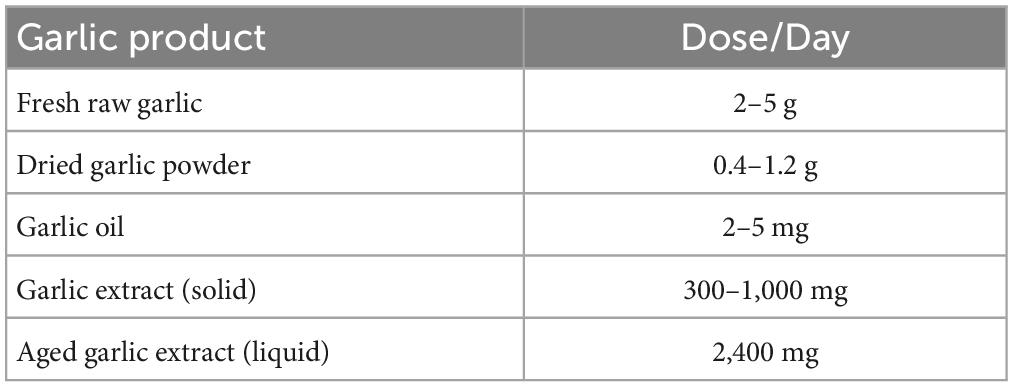
Table 1. Various garlic product and their daily dose (17).
5. Types of garlic products available in the market
Garlic products can be categorized under different categories like garlic powder, garlic oil macerate, aged garlic extract and garlic essential oil. Description of various garlic products are elaborated in the Figure 3.
6. Chemical changes in garlic after processing
Raw garlic bulbs have an abundance of γ-glutamyl-cysteine in intact form. Alliin forms naturally from these components when stored under low temperatures. The enzyme alliinase breakdown alliin to create thiosulfinates like allicin after the garlic has undergone processing operations like chopping, chewing or crushing, or any other operations that disrupt the cell membrane. Allicin and other thiosulfinates breakdowns into DAS, diallyl trisulfide (DAT), DADS, dithiins, and ajoene very instantaneously while simultaneously γ-glutamyl-cysteine is converted to SAC by a different mechanism (18). Thiosulfinates, especially alliin is the most common precursor responsible for garlic’s flavor and these sulfur compounds are also responsible for garlic’s well-known therapeutic properties (19). Various Bioactive components produced when garlic undergoes processing are given in Figure 4.
7. Health benefits of garlic
Have studied the effects of garlic consumption on decreasing total cholesterol (TC) and low-density lipoprotein (LDL) is more pronounced with a lower dosage and longer duration, especially in individuals with cardiovascular diseases (20). Raw garlic and garlic extract in the form of oil or powder can be utilized as functional and therapeutic food. There is significant evidence that indicates preventive and therapeutic roles of garlic in improving the immune system, anti-tumor properties and antioxidant activity of garlic protects the body against free radicals (21, 22). Human health has been found to benefit from a balanced diet rich in functional foods prepared with garlic. Garlic can alter blood anticoagulant levels and boost the activity of various organs in the body mainly of respiratory and digestive systems (23). According to evidence from preclinical investigations and clinical trials, garlic consumption appears to have a significant impact on antihypertensive (24), antidiabetic (25), immune-modulatory (26) and hypolipidemic effects (27) and it would be highly beneficial for medical and surgical treatments (28). Garlic is reported to lower the amount of the gastrointestinal illness-causing cryptosporidiosis in immunocompromised mice and reduced inflammation (29). Garlic alone can give us over 200 unique chemicals that can help in strengthening the immune system and help fight the body against a range of ailments. Garlic’s bioactive components can be protected using encapsulation techniques (30). Under biotic and abiotic stress circumstances, garlic extract has been demonstrated to enhance crop quality and soil conditions (31). When compared to neem oil, clove oil, and tulsi oil, garlic oil is more efficient against aerobic bacteria (32). A list of health benefits associated with various types of garlic products, along with their bioactive components is given in Table 2.
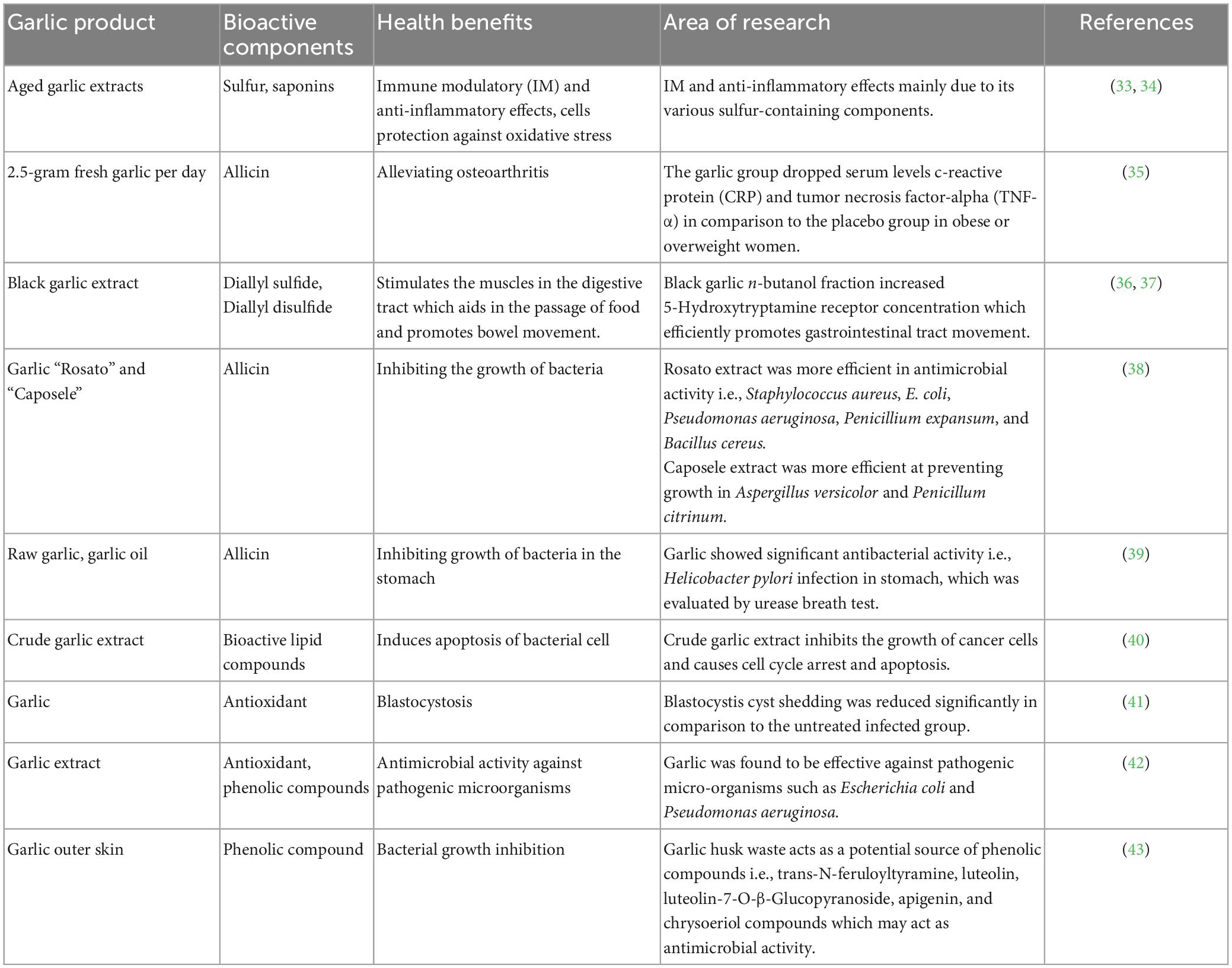
Table 2. List of health benefits associated with different types of garlic product along with its bioactive components.
7.1. Anti-viral properties
Garlic and its oligosaccharides have been proven in preclinical testing to exhibit antiviral properties (44). Demonstrated the antiviral effects of aqueous Garlic extracts against coronavirus (co-treatment and post-treatment). Garlic extracts have been proven to be effective against embryonic eggs that are infected with the coronavirus in aqueous form, suggesting that they may stop or lessen viral proliferation (45). Garlic has been used to cure a variety of infections in Africa, including sexually transmitted diseases, tuberculosis, wounds, and infections of lungs (46). High organosulfur compounds in garlic essential oil are reported to interact strongly with the amino acids of the angiotensin-converting enzyme (ACE2) protein which prevent COVID-19 and the PDB6LU7 protein (main protease of SARS-CoV-2) (47). Garlic has been studied in a huge number of preclinical antiviral investigations against viruses with effective results in Table 3.
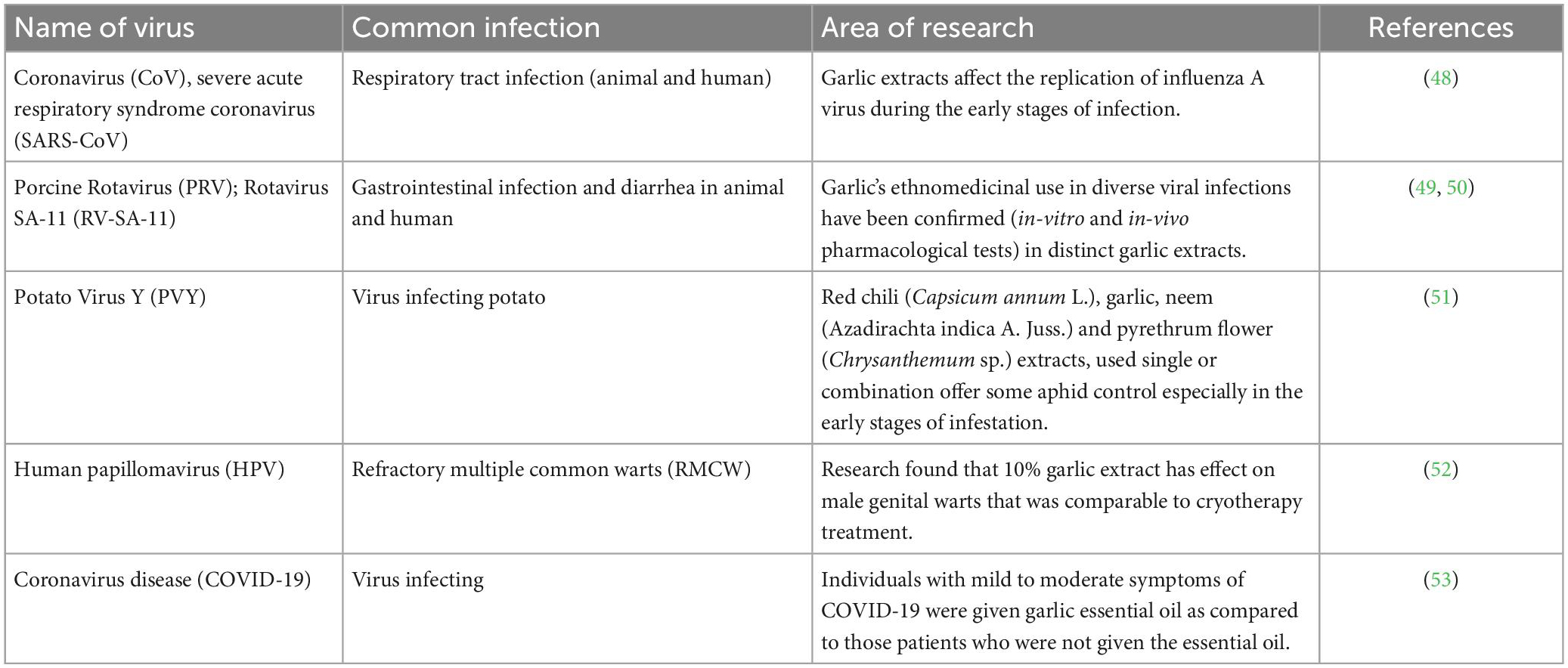
Table 3. Effect of garlic’s various Organo Sulfur Compounds (OSCs) and its extract on various types of viruses.
7.2. Anti-microbial properties
Garlic contains compounds that can prevent bacterial proliferation or cause apoptosis without harming the infected organism. To fight these microorganisms, garlic is considered as strong as broad-spectrum antibiotics (54). Discovered that chloroform extract of aged and non-aged garlic extract had a remarkable antimicrobial activity against Staphylococcus aureus, Salmonella enterica, E. coli (Escherichia coli), and Listeria monocytogenes. Garlic is reported to be more effective with fewer side effects than commercial antibiotics; as a result, it may be utilized as a substitute for antibiotics (55). Garlic has recently been found to exhibit antibacterial properties against a wide spectrum of gram-negative bacteria such as Aeromonas hydrophila (56), Pseudomonas aeruginosa (57), E. coli (58), and gram-positive bacteria such as Bacillus cereus (54), Streptococcus mutans (59), Staphylococcus epidermidis (60) and Methicillin-resistant Staphylococcus aureus (61). Garlic extracts have a broad antibacterial spectrum that includes gram-negative and gram-positive microorganisms (62). Garlic extracts demonstrate antibacterial activity due to various bioactive components present in them which breaks down bacterial cell membrane resulting in bacterial cell death (63).
7.3. Anti-fungal properties
Garlic extracts were found to possess broad-spectrum fungicidal activity against Candida (64, 65), Trichophyton (66), Aspergillus (65) and Rhodotorula spp (67). Garlic extract which acts as antifungal (68) and prevent the growth Meyerozyma guilliermondii and Rhodotorula mucilaginosa (69). Additionally, garlic oil can be applied externally to cure ringworm, warts, and skin parasites (70). A study carried out synthesis of environment-friendly silver nanoparticles using hill garlic extract with enhanced antifungal properties (71). Garlic oil mainly include ingredients viz. disulfides (36%), trisulfides (32%) and monosulfides (29%) which have strong antifungal activity i.e., Penicillium funiculosum (47).
7.4. Anti-tumor properties
Garlic extract ability to inhibit cancer growth activity in vivo against bladder cancer prevention (72). Garlic’s ability to inhibit cancer growth i.e., tumor vessel formation by inducing the expression of survival genes work based on stimulating helper T-cells which is linked to helping the immunity system fight various infections as well as cancer (73). Garlic showed strong anti-cancer activity, particularly in connection to digestive tract tumors. Consumption of garlic reduced the risk of esophagus, stomach, and colon cancer, according to human population research (74). Several bioactive compounds in garlic including DATS, allicin, DADS, diallyl sulfide, and allyl mercaptan have anticancer properties (75).
7.5. Anti-oxidant properties
Garlic’s nutritional and phenolic compounds have excellent antioxidant status in cancer, post-prandial lipemia patients, reducing oxidative stress (76, 77). Garlic’s antioxidant effect is due to its ability to modulate ROS while also raising glutathione and cellular antioxidant enzymes (78). It has been shown that aged garlic extracts (AGE) are effective against atherosclerosis as it helps in the reduction of reactive oxygen species (ROS) and thus prevent endothelial activation and dysfunction (79).
7.6. Cardiovascular protection
Garlic can lower blood lipids, decrease CVD risk factors, and improve HDL levels in addition to enhancing cardiovascular parameters such microcirculation, epicardial and perivascular adipose tissue, post occlusive reactive hyperemia, and carotid artery intima media thickness (75). Garlic has the potential for reducing cardiovascular diseases since it lowers both systolic and diastolic blood pressure (80). It is a well-established fact that Garlic is having many cardiovascular protection properties as shown in Figure 5.
7.6.1. Anti-hypertensive properties
The antihypertensive action of garlic is mainly due to organosulfur compounds, which promote factors that relax endothelium and lowering blood pressure (81). Garlic extracts have been shown to be effective in aqueous form against coronavirus-infected embryonic eggs, suggesting that they may prevent or reduce viral growth (82). Furthermore, garlic was found to be effective in preventing thrombosis and platelet adhesion or aggregation in people (83).
7.6.2. Anti-hyperlipidemic activity
Processing 1.5% black garlic lowered total cholesterol, alter triglyceride and low-density lipoprotein cholesterol in rats fed a diet which having high in cholesterol (84, 85). Aged garlic extract (AGE) was found to lower the blood pressure by 3.75 mm Hg systolic and 3.39 mm Hg diastolic, whereas garlic supplements lowered blood pressure by about 10 mm Hg systolic and 8 mm Hg diastolic, similar to that of conventional BP medication (86).
7.6.3. Anti-atherosclerotic activity
Dyslipidemia and inflammation are major indications of atherosclerosis, a chronic disease, which develops depending on several factors (87). Atherosclerosis builds up over time in human arteries as plaque and might go unnoticed for a long period (88). Garlic preparation has direct anti-atherogenic action and inhibits the development of cholesterol-induced experimental atherosclerosis (89). Garlic extracts inhibited sialidase activity in blood plasma, which is the major cause of the formation of atherogenic low-density lipoprotein (90).
7.6.4. Heart disease
Heart disease is considered to be one of the biggest causes of death worldwide, which includes heart-related diseases like hypertension. Studies have shown that garlic can help people who are suffering from hypertension by lowering their blood pressure (91). By partially increasing Na+/K+-ATPase levels, garlic and its identified metabolites can inhibit iso-induced hypertrophic development in rat heart tissue and H9C2 cell lines (92). In people with moderate hypercholesterolemia, aged black garlic (AGD) extract with a standardized SAC yield in conjunction with dietary suggestions about cardiovascular diseases (CVD) risk factors (93). Garlic and garlic include selenium (Se) has also been shown to reduce blood cholesterol, which is a key factor in causing heart disease (94, 95).
7.7. Anti-diabetic properties
Diabetes, often known as diabetes mellitus, is a fatal metabolic disorder characterized by high blood sugar levels mainly due to the body either cannot use insulin effectively or does not produce enough of it (96). Preclinical research demonstrated that garlic’s active sulfur-containing compounds lowered hyperglycemia by enhancing the antioxidant capacity in diabetic rat circulatory systems (97). Furthermore, the garlic component functions as a donor of hydrogen sulfide, which regulates type 2 diabetes (98). Garlic (300 mg garlic two times per day for 12 weeks) significantly improved blood triglycerides, LDL and lower glucose parameters (99). Furthermore, compared to placebo diabetic patients with uncontrolled dyslipidemia, decreased serum lipid levels.
7.8. Anti-rheumatic properties
Osteoarthritis (OA), is a degenerative disease of the bone joints that causes chronic and severe pain (35). After 12 weeks of treatment, a garlic supplementation of 1,000 mg per day was found to be useful in the alleviation of symptoms in obese women suffering from osteoarthritis in the knees. Furthermore, garlic tablets (500 mg twice a day for 12 weeks) have anti-inflammatory and painkiller effects, lowering serum resistance and TNF- α levels as well as pain intensity in obese women with osteoarthritis of the knee (35). Garlic tablet acts as an antioxidant in postmenopausal women suffering from osteoporosis, and reduction in oxidative stress, according to a randomized clinical study (100).
8. Effect on male fertility
Garlic contains sulfur compounds influence the activity of the enzyme family’s glutathione S-transferase (GST) which is known to detoxify carcinogens and cytochrome P450 (CYP), which is known to activate a variety of chemical carcinogens in test animals (101). Moreover, the Antioxidant activity of garlic can help with fertility by lowering the peroxidation of lipids (102). Research has also found that the antioxidant effects of garlic can minimize the toxicity of damaging medications on the testes while also increasing spermatogenesis and fertility in men (103). Garlic possesses phytoestrogens, which have a direct influence on estrogen (104). Research has revealed that ROS which linked to the development of male infertility, plays a critical role in the disruption of the spermatogenesis process i.e., diminished ability of the genital system’s and sperm’s antioxidant system (105, 106). Diallyl disulfide present in garlic, protects the sexual organs by reducing ROS, improving and strengthening the blood-testis barrier, and increasing blood flow in the testicles (107).
9. Mechanism of action of phyto-constituents in garlic
Allicin and its metabolites can be identified in the blood, feces, and urine after ingesting 25 g of raw garlic which is responsible for most of the therapeutic activity and it is converted to allyl-mercaptan almost immediately under an enzyme-inhibiting gastrointestinal environment (108). According to studies conducted on raw garlic and preparation products, the primary sulfur-containing groups display varying bioavailability between raw garlic and various garlic formulations like water-soluble organo-sulfur compound SAMC has anti-oxidant properties which inhibits cell proliferation, boosts apoptosis in cancer cell lines (109) and SAC which has a blockage of nitrosamine generation and bioactive whereas oil soluble organo-sulfur compound i.e., allicin has suppressed the proliferation of cancer cells, increased apoptosis by activation of caspases and diallyl-disulfide inhibit Colon cancer by suppressing the growth of neoplastic Canine Mammary Tumor cell (CMT-13) and N acetyltransferase (10, 110, 111). The higher bioavailability of allicin (the main bioactive compound of garlic), allyl methyl sulfide in garlic-based foods as compared to crushed raw garlic (112) and higher bioavailability of allicin in enteric tablets was more than in garlic capsules. At body temperature cystine which is released from protein diet interacts with allicin in gastrointestinal tract (GI) tract to generate two S-allylmercaptocysteine (SAMC) derivatives (113). Allicin’s secondary metabolites, such as E ajoene, 2-ethenyl-4-H1, 3-dithiin, and DADS, can be found in the blood and urine after the metabolism of allicin (114). The mechanism of action of various phytoconstituents in garlic as it passes through the gastrointestinal tract is given in Figure 6.
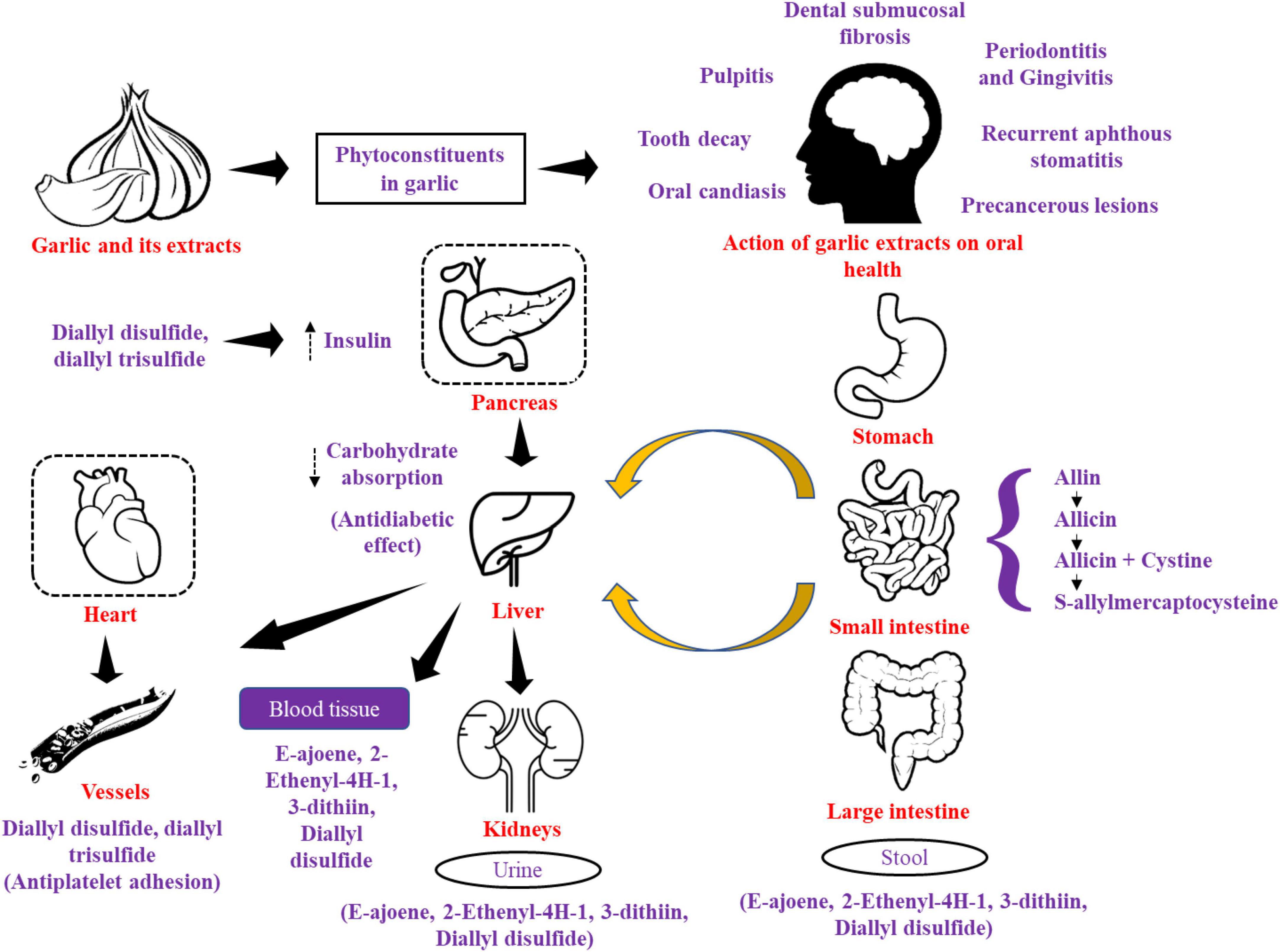
Figure 6. Mechanism of action of various phytoconstituents in garlic as it passes through gastrointestinal tract.
10. Garlic essential oils: Their composition and properties
Garlic which has medicinally chemicals compounds primarily γ-l-glutamyl-l-cysteine, is found in mature garlic bulbs (115). The amino acid alliin, which is an alkyl derivative of cysteine alkyl sulfoxide, is the major component in whole garlic bulbs. The enzyme alliinase is released when tissues are crushed, chewing that converts cytosolic cysteine sulfoxides (alliin) into thiosulfinates (Figure 7). These substances are smelly, volatile and reactive (18, 116).
Garlic oil (GO) which is utilized in many medical garlic products, is created by steam distilling mashed garlic and creating organo-sulfur compounds and yields between 0.09 and 0.35 % of the fresh weight (117). Tocmo et al. (118) assert that DATS is more prevalent in fresh GO than commercial oils, with the number of DADS varying depending on the temperature or duration of the extraction process. The amount and number of constituents in essential oils vary, but in all investigations reported diallyl disulfide is almost always the main ingredient followed by allyl disulfide, allyl trisulfide (119). These substances are the transformation products from allicin, a substance with significant medicinal value because it has a wide range of biological activities. However, allicin is also the most unstable of all the thiosulfinates produced by the vascular enzyme allinase, which is released after tissue damage (120). GO is particularly a good source of organosulfur compounds, primarily allyl disulfide (28.4%), allyl trisulfide (22.8%), allyl-1-propenyl disulfide (8.2%), allyl methyl trisulfide (6.7%), and diallyl tetrasulfide (6.5%) (121). These compounds have potent antioxidant, antibacterial, antithrombotic, and immunomodulatory properties as well as hypotension, anticancer and antimicrobial effects (121) (Figure 8).
10.1. Antimicrobial
The antimicrobial action of undiluted form of GO is 900 times more potent than fresh garlic and 200 times more potent than garlic powder (122). Another allicin-derived molecule called allyl methyl sulfide is reasonably stable in blood, suggesting that the use of GO in the treatment of numerous infectious disorders (123). According to Li et al. (124), diallyl disulfide a significant organo-sulfur component of GO inhibits the transcription of P. aeruginosa’s important genes to suppress the growth of virulence factors. In the food industry, fresh GO is utilized as a natural antioxidant, flavoring ingredient, and antibacterial, especially in gram-negative bacteria like Escherichia coli and Pseudomonas aeruginosa in processed chicken and meat products (125). The antifungal effectiveness of tomato plant Alternaria leaf spot disease produced by essential oil-encapsulated lipid nanoemulsions (126). Natural ingredients i.e., rosemary essential oils and GO which limited the growth of aerobic microorganisms, S. aureus, Salmonella spp., B. thermosphacta, molds and yeasts, lactic acid bacteria and coliform that act natural preserve meat and meat products (127).
10.2. Antioxidant
The antioxidant capacity of wet and dry heated garlic (70, 100, and 121°C) was investigated and it was reported that heating diminishes antioxidant potential due to the breakdown of phenolics and sulfur-containing compounds (128, 129) found that even at a dose of 200 mg of GO demonstrated strong antioxidant activity which was comparable to vitamin C.
10.3. Cardiovascular
According to earlier research, consuming garlic power reduced blood pressure, total cholesterol, low-density lipoprotein, and other risk factors that could lead to cardiovascular disorders (130). In clinical trials, GO has exhibited significant applications in CVDs including intracellular calcium overload, oxidative stress, inflammation, vascular endothelial cell injury and dysfunction, and dyslipidemia (131).
10.4. Antihypertensive
According to data, people who consume more garlic are more likely to have low blood pressure (132). According to epidemiological research, there is a correlation between garlic consumption and hypertension in rats, which lowers the risk of cardiovascular problems (133). Biological activities of GOs such as angiotensin-converting enzymes which have inhibitory potential, α-amylase and α-glucosidase which have inhibition potential antihypertensive activity, and antidiabetic activity (25).
10.5. Anti-cancer
It has been shown that the components of GO which contain diallyl sulfide and diallyl disulfide compound prevented mutagenesis by blocking cytochrome P-450 2E1, which is required for the conversion of the cancer cells (134). When treating cancer, essential oils (EOs) can be combined with synthetic drugs which can boost immunity (135). Greater celandine (Chelidonium majus L.) essential oil-infused chitosan nanoparticles as an anticancer agent on the MCF-7 cell line (136). In experimental carcinogenesis models for several forms of cancer, the major components of GO, such as DAS, DADS, and DATS, were found to inhibit both the initiation and promotion stages of tumorigenesis (137).
10.6. Antidiabetic
In one clinical trial, Zhang et al. (134) gave gelatin capsules containing 8.2 mg of GO daily to the test group for 11 weeks and showed that chronic GO consumption significantly reduced blood sugar levels in the treated female portion of the group, while men group displayed an increase in blood sugar levels. A study revealed that there are gender disparities in the benefits of garlic and healthy men must take more GO supplements in order to have the desired effects on blood sugar and cardiovascular health (138).
11. Possible toxicities of garlic and garlic essential oil
The U.S. Food and Drug Administration has classified garlic as “Generally regarded as safe (GRAS)” for food and flavoring ingredients, although there are severe consequences of reported acute and chronic toxicity on its excessive consumption. Allicin, a substance abundant in garlic, when consumed in large doses, can be hazardous to the liver (139). Additionally, the abundance of different sulfuryl derivatives in essential oils may worsen its harmful effect such as throat and mouth burning, stomach ulcers, nausea, vomiting, erythematous mucosa which is characterized by redness and inflammation in the gas mucosa layer as well as hyphaemia, bleeding gums and potentially irreversible eyesight loss (121). The organosulfur compounds having possible toxicity i.e., endotoxin-induced systemic inflammation and intestinal damage is reported by a study (140).
12. Industrial application
Garlic is used in both cooking and medicine. Compelling evidence reports its possess anti-inflammatory, anti-hypertensive, anti-anemic, anti-hyperlipidemic, anticarcinogenic, antiaggregant, antioxidant, antiviral, anti-microbial, anti-fungal, and antiviral activities. Increased shelf life of all examined goods was enhanced by using fresh garlic and ready-to-eat garlic products with antioxidant properties that reduced the amount of free radical-scavenging activity and increase total polyphenol content (141). These beneficial components in garlic could be used to great success in the creation of foods and nutritional supplements for young children, pregnant or nursing women, cancer and cardiovascular death rates, as well as severe side events and morbidity after garlic therapy.
12.1. Garlic-based snack foods
Various garlic-based snack products have been developed as a result of studies which are given in Table 4. Commercially available garlic-based snack foods are given in Table 5.
13. Herb-drug interactions
The possibility of interactions between herbal medicines and conventional pharmaceuticals is a significant safety concern with the increased usage of herbs. Herb-drug interactions have the same mechanisms as drug-drug interactions and can act both pharmacokinetic (changes in plasma drug concentration) and pharmacodynamic (drugs interact at receptors on target organs) levels (146). The induction (or inhibition) of hepatic and intestinal drug-metabolizing enzymes, specifically cytochrome P450 (CYP) and/or drug transporters like P-glycoprotein, as well as pharmacokinetic interactions, which have been more thoroughly studied, maybe the cause of the altered drug concentrations caused by co-administration of herbs (147). Clinical research indicates that ingesting garlic may cause pharmacodynamic interactions that could pose a risk to individuals on conventional medications, especially in those taking antihypertensive, anticoagulant, or hypoglycemic medications. Garlic interacts with antihypertensive medications that are prescribed to control blood pressure. Additionally, it interacts with Saquinavir and low therapeutic properties the amount of medication in the blood and circulatory system (148). Garlic enhances the effects of drugs that decrease cholesterol and lower blood pressure in the body (149). Garlic’s impact on hypoglycemic medications increases the likelihood of hypoglycemia, among other drug interactions (150). Anticoagulants including heparin, warfarin, and aspirin interact with the garlic plant to increase the risk of bleeding (149). Additionally, garlic increases the fibrinolytic and platelet-activating anti-factor activities in anesthesia (148).
14. Conclusion
Garlic is a aromatic herbaceous plant that is used as an essential ingredient in ready-to-eat snacks foods to enhance the flavor of the product and also improve the therapeutic, functional value and shelf life. Additionally, garlic is rich in organosulfur and flavonoid compounds which are effective in the management of wide range of health disorders, and may be a useful remedy in the prevention of COVID-19. Snacks can be nutritionally enriched by incorporating garlic extracts. The multifunctional therapeutic role of Garlic is attributed to its rich phytocompounds and their several bioactive properties including anti-microbial, anti-inflammatory, anti-hypertensive, anticarcinogenic, antifungal, antiviral, and antioxidant. More standard experiments and clinical studies are needed to back up the claims of garlic in the treatment and prevention of various diseases.
Author contributions
TV, PD, AA, and RS: conceptualization, methodology, investigation, data collection, and writing—original manuscript. SR, K-TC, AC, and RS: editing and proofreading. RS and TV: supervision. All authors approved submission of the final manuscript.
Funding
This study was supported by a grant (no. RA112001) from the Tainan Municipal Hospital (Managed by Show Chwan Medical Care Corporation), Tainan, Taiwan.
Acknowledgments
We acknowledge Banaras Hindu University for their kind support and facilities provided. Sincere thanks are extended to Institution of Eminence (IoE) Scheme, Banaras Hindu University, Varanasi (UP) India for support under Incentive to Seed Grant under IoE Scheme (Devt scheme no. 6031 and PFMS scheme no. 3254).
Conflict of interest
The authors declare that the research was conducted in the absence of any commercial or financial relationships that could be construed as a potential conflict of interest.
Publisher’s note
All claims expressed in this article are solely those of the authors and do not necessarily represent those of their affiliated organizations, or those of the publisher, the editors and the reviewers. Any product that may be evaluated in this article, or claim that may be made by its manufacturer, is not guaranteed or endorsed by the publisher.
References
1. Renub Research,. India snacks market by sector, types, region, company analysis, forecast [Online]. (2021). Available online at: https://www.renub.com/india-snacks-market-forecast-organized-unorganized-companies-consumer-survey-p.php (accessed March 10, 2022).
2. Singh N, Rao AS, Nandal A, Kumar S, Yadav SS, Ganaie SA, et al. Phytochemical and pharmacological review of Cinnamomum verum J. Presl-a versatile spice used in food and nutrition. Food Chem. (2021) 338:127773. doi: 10.1016/j.foodchem.2020.127773
3. Alam K, Hoq O, Uddin S. Medicinal plant Allium sativum. A review. J Med Plant Stud. (2016) 4:72–9.
4. Javed M, Ahmed W, Mian R, Ahmad AMR. Garlic as a potential nominee in functional food industry. In: Ahmad RS editor. Herbs and spices-new processing technologies. London: IntechOpen (2021). doi: 10.5772/intechopen.99819
5. Puvaca N. Bioactive compounds in dietary spices and medicinal plants. J Agron Technol Eng Manag. (2022) 5:704–11. doi: 10.55817/UHFO5592
6. Ashfaq F, Ali Q, Haider MA, Hafeez MM, Malik A. Therapeutic activities of garlic constituent phytochemicals. Biol Clin Sci Res J. (2021) 2021:e007. doi: 10.54112/bcsrj.v2021i1.53
7. Khubber S, Hashemifesharaki R, Mohammadi M, Gharibzahedi SMT. Garlic (Allium sativum L.): a potential unique therapeutic food rich in organosulfur and flavonoid compounds to fight with COVID-19. Nutr J. (2020) 19:1–3. doi: 10.1186/s12937-020-00643-8
8. Aggarwal A, Verma T, Rai DC, Sharma R. Post-COVID-19 trends in indian dairy industry: current challenges, recoveries and future strategies. Indian Vet J. (2022) 99:7–15.
9. United States Department of Agriculture [USDA]. Garlic, raw [Online]. (2019). Available online at: https://fdc.nal.usda.gov/fdc-app.html#/food-details/169230/nutrients (accessed March 11, 2022).
10. Shang A, Cao SY, Xu XY, Gan RY, Tang GY, Corke H, et al. Bioactive compounds and biological functions of garlic (Allium sativum L.). Foods. (2019) 8:246. doi: 10.3390/foods8070246
11. Yang D, Dunshea FR, Suleria HA. LC-ESI-QTOF/MS characterization of Australian herb and spices (garlic, ginger, and onion) and potential antioxidant activity. J Food Process Preserv. (2020) 44:e14497. doi: 10.1111/jfpp.14497
12. Berginc K, Milisav I, Kristl A. Garlic flavonoids and organosulfur compounds: impact on the hepatic pharmacokinetics of saquinavir and darunavir. Drug Metab Pharmacokinet. (2010) 25:521–30. doi: 10.2133/dmpk.DMPK-10-RG-053
13. Kopec A, Skoczylas J, Jȩdrszczyk E, Francik R, Bystrowska B, Zawistowski J. Chemical composition and concentration of bioactive compounds in garlic cultivated from air bulbils. Agriculture. (2020) 10:40. doi: 10.3390/agriculture10020040
14. Beato VM, Orgaz F, Mansilla F, Montaño A. Changes in phenolic compounds in garlic (Allium sativum L.) owing to the cultivar and location of growth. Plant Foods Hum Nutr. (2011) 66:218–23. doi: 10.1007/s11130-011-0236-2
15. Rouf R, Uddin SJ, Sarker DK, Islam MT, Ali ES, Shilpi JA, et al. Antiviral potential of garlic (Allium sativum) and its organosulfur compounds: a systematic update of pre-clinical and clinical data. Trends Food Sci Technol. (2020) 104:219–34.
16. Kovarovic J, Bystricka J, Vollmannova A, Toth T, Brindza J. Biologically valuable substances in garlic (Allium sativum L.)–A review. J Cent Eur Agric. (2019) 20:292–304. doi: 10.5513/JCEA01/20.1.2304
17. Sativi BA. WHO Monographs on Selected Medicinal Plants, Vol. 1. Geneva: World Health Organization (1999). 16–32.
18. Ozma MA, Abbasi A, Ahangarzadeh Rezaee M, Hosseini H, Hosseinzadeh N, Sabahi S, et al. A critical review on the nutritional and medicinal profiles of garlic’s (Allium sativum L.) bioactive compounds. Food Rev Int. (2022) 24:1–38. doi: 10.1080/87559129.2022.2100417
19. Rauf A, Abu-Izneid T, Thiruvengadam M, Imran M, Olatunde A, Shariati MA, et al. Garlic (Allium sativum L.): its chemistry, nutritional composition, toxicity, and anticancer properties. Curr Top Med Chem. (2022) 22:957–72. doi: 10.2174/1568026621666211105094939
20. Li S, Guo W, Lau W, Zhang H, Zhan Z, Wang X, et al. The association of garlic intake and cardiovascular risk factors: a systematic review and meta-analysis. Crit Rev Food Sci Nutr. (2022). doi: 10.1080/10408398.2022.2053657 [Epub ahead of print].
21. Cheng H, Huang G, Huang H. The antioxidant activities of garlic polysaccharide and its derivatives. Int J Biol Macromol. (2020) 145:819–26. doi: 10.1016/j.ijbiomac.2019.09.232
22. Sasaki JI, Lu C, Machiya E, Tanahashi M, Hamada K. Processed black garlic (Allium sativum) extracts enhance anti-tumor potency against mouse tumors. Energy. (2007) 227:138.
23. Lee GY, Lee JJ, Lee SM. Antioxidant and anticoagulant status were improved by personalized dietary intervention based on biochemical and clinical parameters in cancer patients. Nutr Cancer. (2015) 67:1083–92. doi: 10.1080/01635581.2015.1073754
24. Hussein HJ, Hameed IH, Hadi MY. A Review: anti-microbial, Anti-inflammatory effect and Cardiovascular effects of Garlic: Allium sativum. Res J Pharm Technol. (2017) 10:4069–78. doi: 10.5958/0974-360X.2017.00738.7
25. Mutlu-Ingok A, Devecioglu D, Dikmetas DN, Karbancioglu-Guler F. Advances in biological activities of essential oils. Stud Nat Prod Chem. (2022) 74:331–66. doi: 10.1016/B978-0-323-91099-6.00010-4
26. Kumari N, Kumar M, Radha R, Lorenzo JM, Sharma D, Puri S, et al. Onion and garlic polysaccharides: a review on extraction, characterization, bioactivity, and modifications. Int J Biol Macromol. (2022) 219:1047–61. doi: 10.1016/j.ijbiomac.2022.07.163
27. Perez-Rubio KG, Méndez-del Villar M, Cortez-Navarrete M. The role of garlic in metabolic diseases: a review. J Med Food. (2022) 25:683–94. doi: 10.1089/jmf.2021.0146
28. Daharia A, Jaiswal VK, Royal KP, Sharma H, Joginath AK, Kumar R, et al. A Comparative review on ginger and garlic with their pharmacological Action. Asian J Pharm Res Dev. (2022) 10:65–9. doi: 10.22270/ajprd.v10i3.1147
29. Farid A, Yousry M, Safwat G. Garlic (Allium sativum Linnaeus) improved inflammation and reduced cryptosporidiosis burden in immunocompromised mice. J Ethnopharmacol. (2022) 292:115174. doi: 10.1016/j.jep.2022.115174
30. Tavares L, Santos L, Noreña CPZ. Bioactive compounds of garlic: a comprehensive review of encapsulation technologies, characterization of the encapsulated garlic compounds and their industrial applicability. Trends Food Sci Technol. (2021) 114:232–44. doi: 10.1016/j.tifs.2021.05.019
31. Hayat S, Ahmad A, Ahmad H, Hayat K, Khan MA, Runan T. Garlic, from medicinal herb to possible plant bioprotectant: a review. Sci Hortic. (2022) 304:111296. doi: 10.1016/j.scienta.2022.111296
32. Isani A, Masih U, Joshi K. Ex vivo comparative evaluation of efficacy of disinfecting ability of garlic oil, neem oil, clove oil and tulsi oil with autoclaving on endodontic K files, tested against aerobic bacteria. Univ J Dent Sci. (2020) 6:27–31. doi: 10.21276/ujds.2020.6.3.6
33. Rodrigues C, Percival SS. Immunomodulatory effects of glutathione, garlic derivatives, and hydrogen sulfide. Nutrients. (2019) 11:295. doi: 10.3390/nu11020295
34. Miraghajani M, Rafie N, Hajianfar H, Larijani B, Azadbakht L. Aged garlic and cancer: a systematic review. Int J Prevent Med. (2018) 9:84. doi: 10.4103/ijpvm.IJPVM_437_17
35. Dehghani S, Alipoor E, Salimzadeh A, Yaseri M, Hosseini M, Feinle-Bisset C, et al. The effect of a garlic supplement on the pro-inflammatory adipocytokines, resistin and tumor necrosis factor-alpha, and on pain severity, in overweight or obese women with knee osteoarthritis. Phytomedicine. (2018) 48:70–5. doi: 10.1016/j.phymed.2018.04.060
36. Chen C, Liu CH, Cai J, Zhang W, Qi WL, Wang Z, et al. Broad-spectrum antimicrobial activity, chemical composition and mechanism of action of garlic (Allium sativum) extracts. Food Control. (2018) 86:117–25. doi: 10.1016/j.foodcont.2017.11.015
37. Chen YA, Tsai JC, Cheng KC, Liu KF, Chang CK, Hsieh CW. Extracts of black garlic exhibits gastrointestinal motility effect. Food Res Int. (2018) 107:102–9. doi: 10.1016/j.foodres.2018.02.003
38. Fratianni F, Riccardi R, Spigno P, Ombra MN, Cozzolino A, Tremonte P, et al. Biochemical characterization and antimicrobial and antifungal activity of two endemic varieties of garlic (Allium sativum L.) of the campania region, southern Italy. J Med Food. (2016) 19:686–91. doi: 10.1089/jmf.2016.0027
39. Zardast M, Namakin K, Kaho JE, Hashemi SS. Assessment of antibacterial effect of garlic in patients infected with Helicobacter pylori using urease breath test. Avicenna J Phytomed. (2016) 6:495.
40. Bagul M, Kakumanu S, Wilson TA. Crude garlic extract inhibits cell proliferation and induces cell cycle arrest and apoptosis of cancer cells in vitro. J Med Food. (2015) 18:731–7. doi: 10.1089/jmf.2014.0064
41. Abdel-Hafeez EH, Ahmad AK, Kamal AM, Abdellatif MZ, Abdelgelil NH. In vivo antiprotozoan effects of garlic (Allium sativum) and ginger (Zingiber officinale) extracts on experimentally infected mice with Blastocystis spp. Parasitol Res. (2015) 114:3439–44. doi: 10.1007/s00436-015-4569-x
42. Khalid N, Ahmed I, Latif MSZ, Rafique T, Fawad SA. Comparison of antimicrobial activity, phytochemical profile and minerals composition of garlic Allium sativum and Allium tuberosum. J Korean Soc Appl Biol Chem. (2014) 57:311–7. doi: 10.1007/s13765-014-4021-4
43. Kallel F, Driss D, Chaari F, Belghith L, Bouaziz F, Ghorbel R, et al. Garlic (Allium sativum L.) husk waste as a potential source of phenolic compounds: influence of extracting solvents on its antimicrobial and antioxidant properties. Ind Crops Prod. (2014) 62:34–41. doi: 10.1016/j.indcrop.2014.07.047
44. Shojai TM, Langeroudi AG, Karimi V, Barin A, Sadri N. The effect of Allium sativum (Garlic) extract on infectious bronchitis virus in specific pathogen free embryonic egg. Avicenna J Phytomed. (2016) 6:458.
45. Onyiba CI. A systematic review of garlic and ginger as medicinal spices against viral infections. Extsv Rev. (2022) 2:32–44. doi: 10.1016/j.tifs.2020.08.006
46. Tadele KT, Zerssa GW. Specific plant nutrients and vitamins that fortify human immune system. In: Husen A editor. Traditional herbal therapy for the human immune system. Boca Raton, FL: CRC Press (2021). p. 363–96. doi: 10.1201/9781003137955-12
47. Thuy BTP, My TTA, Hai NTT, Hieu LT, Hoa TT, Thi Phuong Loan H, et al. Investigation into SARS-CoV-2 resistance of compounds in garlic essential oil. ACS Omega. (2020)) 5:8312–20. doi: 10.1021/acsomega.0c00772
48. Mehrbod P, Aini I, Amini E, Eslami M, Torabi A, Bande F, et al. Assessment of direct immunofluorescence assay in detection of antiviral effect of garlic extract on influenza virus. Afr J Microbiol Res. (2013) 7:2608–12. doi: 10.5897/AJMR12.2329
49. Crawford SE, Ramani S, Tate JE, Parashar UD, Svensson L, Hagbom M, et al. Rotavirus infection. Nat Rev Dis Primers. (2017) 3:1–16. doi: 10.1038/nrdp.2017.83
50. Vlasova AN, Amimo JO, Saif LJ. Porcine rotaviruses: epidemiology, immune responses and control strategies. Viruses. (2017) 9:48. doi: 10.3390/v9030048
51. Kreuze JF, Souza-Dias JAC, Jeevalatha A, Figueira AR, Valkonen JPT, Jones RAC. Viral diseases in potato. In: Campos H, Ortiz O editors. The potato crop. Cham: Springer (2020). p. 389–430. doi: 10.1007/978-3-030-28683-5_11
52. Mousavi ZB, Mehrabian A, Golfakhrabadi F, Namjoyan F. A clinical study of efficacy of garlic extract versus cryotherapy in the treatment of male genital wart. Dermatol Sin. (2018) 36:196–9. doi: 10.1016/j.dsi.2018.06.007
53. Wang Y, Wu Y, Fu P, Zhou H, Guo X, Zhu C, et al. Effect of garlic essential oil in 97 patients hospitalized with covid-19: a multi-center experience. Pakistan J Pharm Sci. (2022) 35:1077–82.
54. Jang HJ, Lee HJ, Yoon DK, Ji DS, Kim JH, Lee CH. Antioxidant and antimicrobial activities of fresh garlic and aged garlic by-products extracted with different solvents. Food Sci Biotechnol. (2018) 27:219–25. doi: 10.1007/s10068-017-0246-4
55. Gebreselema G, Mebrahtu G. Medicinal values of garlic: a review. Int J Med Med Sci. (2013) 5:401–8.
56. Paul SI, Rahman MM, Salam MA, Surovy MZ, Islam T. Dietary inclusion of garlic (Allium sativum) Extract Enhances Growth and Resistance of Rohu (Labeo Rohita) against motile aeromonas septicaemia. Ann Bangladesh Agric. (2021) 25:11–22. doi: 10.3329/aba.v25i1.58151
57. Vadekeetil A, Saini H, Chhibber S, Harjai K. Exploiting the antivirulence efficacy of an ajoene-ciprofloxacin combination against Pseudomonas aeruginosa biofilm associated murine acute pyelonephritis. Biofouling. (2016) 32:371–82. doi: 10.1080/08927014.2015.1137289
58. Idris AR, Afegbua SL. Single and joint antibacterial activity of aqueous garlic extract and Manuka honey on extended-spectrum beta-lactamase-producing Escherichia coli. Trans R Soc Trop Med Hyg. (2017) 111:472–8. doi: 10.1093/trstmh/trx084
59. Jain I, Jain P, Bisht D, Sharma A, Srivastava B, Gupta N. Comparative evaluation of antibacterial efficacy of six Indian plant extracts against Streptococcus mutans. J Clin Diagn Res. (2015) 9:ZC50. doi: 10.7860/JCDR/2015/11526.5599
60. Wu X, Santos RR, Fink-Gremmels J. Analyzing the antibacterial effects of food ingredients: model experiments with allicin and garlic extracts on biofilm formation and viability of Staphylococcus epidermidis. Food Sci Nutr. (2015) 3:158–68. doi: 10.1002/fsn3.199
61. Girish VM, Liang H, Aguilan JT, Nosanchuk JD, Friedman JM, Nacharaju P. Anti-biofilm activity of garlic extract loaded nanoparticles. Nanomedicine. (2019) 20:102009. doi: 10.1016/j.nano.2019.04.012
62. Fufa BK. Anti-bacterial and anti-fungal properties of garlic extract (Allium sativum): a review. Microbiol Res J Int. (2019) 28:1–5. doi: 10.9734/mrji/2019/v28i330133
63. Choo S, Chin VK, Wong EH, Madhavan P, Tay ST, Yong PVC, et al. Antimicrobial properties of allicin used alone or in combination with other medications. Folia Microbiol. (2020) 65:451–65. doi: 10.1007/s12223-020-00786-5
64. Li WR, Shi QS, Dai HQ, Liang Q, Xie XB, Huang XM, et al. Antifungal activity, kinetics and molecular mechanism of action of garlic oil against Candida albicans. Sci Rep. (2016) 6:22805.
65. Abdallah EM. Potential antifungal activity of fresh garlic cloves (Allium sativum L.) from Sudan. J Biotechnol Res. (2017) 3:106–9.
66. Aala F, Yusuf UK, Nulit R, Rezaie S. Inhibitory effect of allicin and garlic extracts on growth of cultured hyphae. Iran J Basic Med Sci. (2014) 17:150.
67. Al-Bader S. Antifungal activity of nine plant oils against local rhodotorula species and scytalidium dimidiatum. Int J Med Sci. (2019) 2:52–70.
68. Suleiman EA, Abdallah WB. In vitro activity of garlic (Allium sativum) on some pathogenic fungi. Eur J Med Plants. (2014) 4:1240–50. doi: 10.9734/EJMP/2014/10132
69. Pârvu M, Moţ CA, Pârvu AE, Mircea C, Stoeber L, Roşca-Casian O, et al. Allium sativum extract chemical composition, antioxidant activity and antifungal effect against Meyerozyma guilliermondii and Rhodotorula mucilaginosa causing onychomycosis. Molecules. (2019) 24:3958. doi: 10.3390/molecules24213958
70. Papu S, Jaivir S, Sweta S, Singh BR. Medicinal values of garlic (Allium sativum L.) in human life: an overview. Greener J Agric Sci. (2014) 4:265–80.
71. Nallal V, Razia M, Duru OA, Ramalingam G, Chinnappan S, Chandrasekaran M, et al. Eco-Friendly synthesis of multishaped crystalline silver nanoparticles using hill garlic extract and their potential application as an antifungal agent. J Nanomater. (2022) 2022:7613210. doi: 10.1155/2022/7613210
72. Shin SS, Song JH, Hwang B, Noh DH, Park SL, Kim WT, et al. HSPA6 augments garlic extract-induced inhibition of proliferation, migration, and invasion of bladder cancer EJ cells; Implication for cell cycle dysregulation, signaling pathway alteration, and transcription factor-associated MMP-9 regulation. PLoS One. (2017) 12:e0171860. doi: 10.1371/journal.pone.0171860
73. Kim WT, Seo SP, Byun YJ, Kang HW, Kim YJ, Lee SC, et al. The anticancer effects of garlic extracts on bladder cancer compared to cisplatin: a common mechanism of action via centromere protein M. Am J Chin Med. (2018) 46:689–705. doi: 10.1142/S0192415X18500362
74. Wang Y, Huang P, Wu Y, Liu D, Ji M, Li H, et al. Association and mechanism of garlic consumption with gastrointestinal cancer risk: a systematic review and meta analysis. Oncol Lett. (2022) 23:1–16. doi: 10.3892/ol.2022.13245
75. Imaizumi VM, Laurindo LF, Manzan B, Guiguer EL, Oshiiwa M, Otoboni AMMB, et al. Garlic: a systematic review of the effects on cardiovascular diseases. Crit Rev Food Sci Nutr. (2022). doi: 10.1080/10408398.2022.2043821 [Epub ahead of print].
76. Petropoulos S, Fernandes Â, Barros L, Ciric A, Sokovic M, Ferreira IC. Antimicrobial and antioxidant properties of various Greek garlic genotypes. Food Chem. (2018) 245:7–12. doi: 10.1016/j.foodchem.2017.10.078
77. McCrea CE, West SG, Kris-Etherton PM, Lambert JD, Gaugler TL, Teeter DL, et al. Effects of culinary spices and psychological stress on postprandial lipemia and lipase activity: results of a randomized crossover study and in vitro experiments. J Transl Med. (2015) 13:1–12. doi: 10.1186/s12967-014-0360-5
78. Wallock-Richards D, Doherty CJ, Doherty L, Clarke DJ, Place M, Govan JR, et al. Garlic revisited: antimicrobial activity of allicin-containing garlic extracts against Burkholderia cepacia complex. PLoS One. (2014) 9:e112726. doi: 10.1371/journal.pone.0112726
79. Tsuneyoshi T. BACH1 mediates the antioxidant properties of aged garlic extract. Exp Ther Med. (2020) 19:1500–3. doi: 10.3892/etm.2019.8380
80. Varshney R, Budoff MJ. Garlic and heart disease. International Garlic Symposium: role of garlic in cardiovascular disease prevention, metabolic syndrome and immunology. J Nutr. (2016) 2:202–333.
81. Piragine E, Citi V, Lawson K, Calderone V, Martelli A. Regulation of blood pressure by natural sulfur compounds: focus on their mechanisms of action. Biochem Pharmacol. (2022) 206:115302. doi: 10.1016/j.bcp.2022.115302
82. Ried K, Fakler P. Potential of garlic (Allium sativum) in lowering high blood pressure: mechanisms of action and clinical relevance. Integr Blood Press Control. (2014) 7:71. doi: 10.2147/IBPC.S51434
83. Gonzalez RE, Soto VC, Sance MM, Galmarini CR. Garlic inhibitory effect on platelet activity induced by different agonists. La Rev de la Facul de Cienc Agrarias. (2021) 53:46–54. doi: 10.48162/rev.39.005
84. Ha AW, Ying T, Kim WK. The effects of black garlic (Allium satvium) extracts on lipid metabolism in rats fed a high fat diet. Nutr Res Pract. (2015) 9:30–6. doi: 10.4162/nrp.2015.9.1.30
85. Sohn CW, Kim H, You BR, Kim MJ, Kim HJ, Lee JY, et al. High temperature-and high pressure-processed garlic improves lipid profiles in rats fed high cholesterol diets. J Med Food. (2012) 15:435–40. doi: 10.1089/jmf.2011.1922
86. Wang HP, Yang J, Qin LQ, Yang XJ. Effect of garlic on blood pressure: a meta-analysis. J Clin Hypert. (2015) 17:223–31. doi: 10.1111/jch.12473
87. Fredman G, Spite M. Recent advances in the role of immunity in atherosclerosis. Circ Res. (2013) 113:e111–4. doi: 10.1161/CIRCRESAHA.113.302986
88. Kirichenko TV, Sukhorukov VN, Markin AM, Nikiforov NG, Liu PY, Sobenin IA, et al. Medicinal plants as a potential and successful treatment option in the context of atherosclerosis. Front Pharmacol. (2020) 11:403. doi: 10.3389/fphar.2020.00403
89. Sobenin IA, Andrianova IV, Lakunin KY, Karagodin VP, Bobryshev YV, Orekhov AN. Anti-atherosclerotic effects of garlic preparation in freeze injury model of atherosclerosis in cholesterol-fed rabbits. Phytomedicine. (2016) 23:1235–9. doi: 10.1016/j.phymed.2015.10.014
90. Sobenin IA, Myasoedova VA, Iltchuk MI, Zhang DW, Orekhov AN. Therapeutic effects of garlic in cardiovascular atherosclerotic disease. Chin J Nat Med. (2019) 17:721–8. doi: 10.1016/S1875-5364(19)30088-3
91. Espinoza T, Valencia E, Albarrán M, Díaz D, Quevedo RA, Díaz O, et al. Garlic (Allium sativum L) and Its beneficial properties for health: a Review. Agroindustrial Sci. (2020) 10:103–15. doi: 10.17268/agroind.sci.2020.01.14
92. Khatua TN, Borkar RM, Mohammed SA, Dinda AK, Srinivas R, Banerjee SK. Novel sulfur metabolites of garlic attenuate cardiac hypertrophy and remodeling through induction of Na+/K+-ATPase expression. Front Pharmacol. (2017) 8:18. doi: 10.3389/fphar.2017.00018
93. Valls RM, Companys J, Calderón-Pérez L, Salamanca P, Pla-Pagà L, Sandoval-Ramírez BA, et al. Effects of an optimized aged garlic extract on cardiovascular disease risk factors in moderate hypercholesterolemic subjects: a randomized, crossover, double-blind, sustainedand controlled Study. Nutrients. (2022) 14:405. doi: 10.3390/nu14030405
94. Ried K. Garlic lowers blood pressure in hypertensive individuals, regulates serum cholesterol, and stimulates immunity: an updated meta-analysis and review. J Nutr. (2016) 146:389S–96. doi: 10.3945/jn.114.202192
96. Zhu Y, Anand R, Geng X, Ding Y. A mini review: garlic extract and vascular diseases. Neurol Res. (2018) 40:421–5. doi: 10.1080/01616412.2018.1451269
97. Sujithra K, Srinivasan S, Indumathi D, Vinothkumar V. Allyl methyl sulfide, a garlic active component mitigates hyperglycemia by restoration of circulatory antioxidant status and attenuating glycoprotein components in streptozotocin-induced experimental rats. Toxicol Mech Methods. (2019) 29:165–76. doi: 10.1080/15376516.2018.1534297
98. Melino S, Leo S, Toska Papajani V. Natural hydrogen sulfide donors from Allium sp. as a nutraceutical approach in type 2 diabetes prevention and therapy. Nutrients. (2019) 11:1581. doi: 10.3390/nu11071581
99. Shabani E, Sayemiri K, Mohammadpour M. The effect of garlic on lipid profile and glucose parameters in diabetic patients: a systematic review and meta-analysis. Prim Care Diabetes. (2019) 13:28–42. doi: 10.1016/j.pcd.2018.07.007
100. Mozaffari-Khosravi H, Hesabgar HAS, Owlia MB, Hadinedoushan H, Barzegar K, Fllahzadeh MH. The effect of garlic tablet on pro-inflammatory cytokines in postmenopausal osteoporotic women: a randomized controlled clinical trial. J Diet Suppl. (2012) 9:262–71. doi: 10.3109/19390211.2012.726703
101. Bastaki S, Ojha S, Kalasz H, Adeghate E. Chemical constituents and medicinal properties of Allium species. Mol Cell Biochem. (2021) 476:4301–21. doi: 10.1007/s11010-021-04213-2
102. Moher D, Liberati A, Tetzlaff J, Altman DG, Altman D, Antes G, et al. Preferred reporting items for systematic reviews and meta-analyses: the PRISMA statement (Chinese edition). J Chin Integr Med. (2009) 7:889–96. doi: 10.3736/jcim20090918
103. Nasr AY. The impact of aged garlic extract on adriamycin-induced testicular changes in adult male Wistar rats. Acta Histochem. (2017) 119:648–62. doi: 10.1016/j.acthis.2017.07.006
104. Hammami I, Nahdi A, Atig F, Kouidhi W, Amri M, Mokni M, et al. Effects of garlic fractions consumption on male reproductive functions. J Med Food. (2013) 16:82–7. doi: 10.1089/jmf.2011.0335
105. Fanaei H, Azizi Y, Khayat S. A review: role of oxidative stress in male infertility. J Fasa Univ Med Sci. (2013) 3:93–103.
106. Oi Y, Imafuku M, Shishido C, Kominato Y, Nishimura S, Iwai K. Garlic supplementation increases testicular testosterone and decreases plasma corticosterone in rats fed a high protein diet. J Nutr. (2001) 131:2150–6. doi: 10.1093/jn/131.8.2150
107. Mansouri Q, Abdennour C. Evaluation of the therapeutic efficiency of raw garlic on reproduction of domestic rabbits under lead induced toxicity. Ann Biol Res. (2011) 2:389–93.
108. Lawson LD, Ransom DK, Hughes BG. Inhibition of whole blood platelet-aggregation by compounds in garlic clove extracts and commercial garlic products. Thromb Res. (1992) 65:141–56. doi: 10.1016/0049-3848(92)90234-2
109. Kaur G, Gupta R. Garlic: nature’s protection against wounds. Plant Arch. (2021) 21:2446–55. doi: 10.51470/PLANTARCHIVES.2021.v21.S1.398
110. Li C, Jing H, Ma G, Liang P. Allicin induces apoptosis through activation of both intrinsic and extrinsic pathways in glioma cells. Mol Med Rep. (2018) 17:5976–81.
111. Chung JG, Lu HF, Yeh CC, Cheng KC, Lin SS, Lee JH. Inhibition of N-acetyltransferase activity and gene expression in human colon cancer cell lines by diallyl sulfide. Food Chem Toxicol. (2004) 42:195–202. doi: 10.1016/j.fct.2003.08.015
112. Lawson LD, Hunsaker SM. Allicin bioavailability and bioequivalence from garlic supplements and garlic foods. Nutrients. (2018) 10:812. doi: 10.3390/nu10070812
113. Germain E, Auger J, Ginies C, Siess MH, Teyssier C. In vivo metabolism of diallyl disulphide in the rat: identification of two new metabolites. Xenobiotica. (2002) 32:1127–38. doi: 10.1080/0049825021000017902
114. Freeman F, Kodera Y. Garlic chemistry: stability of S-(2-propenyl)-2-propene-1-sulfinothioate (allicin) in blood, solvents, and simulated physiological fluids. J Agric Food Chem. (1995) 43:2332–8. doi: 10.1021/jf00057a004
115. Velíšek J, Kubec R, Cejpek K. Biosynthesis of food constituents: peptides–a review. Czech J Food Sci. (2006) 24:149. doi: 10.17221/3311-CJFS
116. Al-Snafi AE. Pharmacological effects of Allium species grown in Iraq. An overview. Int J Pharm Health Care Res. (2013) 1:132–47.
117. Satyal P, Craft JD, Dosoky NS, Setzer WN. The chemical compositions of the volatile oils of garlic (Allium sativum) and wild garlic (Allium vineale). Foods. (2017) 6:63. doi: 10.3390/foods6080063
118. Tocmo R, Wu Y, Liang D, Fogliano V, Huang D. Boiling enriches the linear polysulfides and the hydrogen sulfide-releasing activity of garlic. Food Chem. (2017) 221:1867–73. doi: 10.1016/j.foodchem.2016.10.076
119. Gong X, Su X, Liu H. Diallyl trisulfide, the antifungal component of garlic essential oil and the bioactivity of its nanoemulsions formed by spontaneous emulsification. Molecules. (2021) 26:7186. doi: 10.3390/molecules26237186
120. Yoshimoto N, Saito K. S-Alk (en) ylcysteine sulfoxides in the genus Allium: proposed biosynthesis, chemical conversion, and bioactivities. J Exp Bot. (2019) 70:4123–37. doi: 10.1093/jxb/erz243
121. Ezeorba TPC, Chukwudozie KI, Ezema CA, Anaduaka EG, Nweze EJ, Okeke ES. Potentials for health and therapeutic benefits of garlic essential oils: recent findings and future prospects. Pharmacol Res Mod Chin Med. (2022) 3:100075. doi: 10.1016/j.prmcm.2022.100075
122. Hussein MMAH, Hassan WH, Moussa IMI. Potential use of allicin (garlic, Allium sativum Linn, essential oil) against fish pathogenic bacteria and its safety for monosex Nile tilapia (Oreochromis niloticus). J Food Agric Environ. (2013) 11:696–9.
123. Tisserand R, Young R. Essential oil safety: a guide for health care professionals. Amsterdam: Elsevier Health Sciences (2013).
124. Li G, Chen P, Zhao Y, Zeng Q, Ou S, Zhang Y, et al. Isolation, structural characterization and anti-oxidant activity of a novel polysaccharide from garlic bolt. Carbohyd Polym. (2021) 267:118194.
125. Yasin G, Jasim SA, Mahmudiono T, Al-Shawi SG, Shichiyakh RA, Shoukat S, et al. Investigating the effect of garlic (Allium sativum) essential oil on foodborne pathogenic microorganisms. Food Sci Technol. (2022) 42:e03822. doi: 10.1590/fst.03822
126. Nguyen MH, Tran TNM, Vu NBD. Antifungal activity of essential oil-encapsulated lipid nanoemulsions formulations against leaf spot disease on tomato caused by Alternaria alternata. Arch Phytopathol Plant Protect. (2022) 55:235–57. doi: 10.1080/03235408.2021.2015887
127. Olivas-Méndez P, Chávez-Martínez A, Santellano-Estrada E, Guerrero Asorey L, Sánchez-Vega R, Rentería-Monterrubio AL, et al. Antioxidant and Antimicrobial Activity of Rosemary (Rosmarinus officinalis) and Garlic (Allium sativum) Essential Oils and Chipotle Pepper Oleoresin (Capsicum annum) on Beef Hamburgers. Foods. (2022) 11:2018. doi: 10.3390/foods11142018
128. Wangcharoen W, Morasuk W. Effect of heat treatment on the antioxidant capacity of garlic. Maejo Int J Sci Technol. (2009) 3:60–70.
129. Romeilah RM, Fayed SA, Mahmoud GI. Chemical compositions, antiviral and antioxidant activities of seven essential oils. J Appl Sci Res. (2010) 6:50–62.
130. Rahman K, Lowe GM. Garlic and cardiovascular disease: a critical review. J Nutr. (2006) 136:736S–40S. doi: 10.1093/jn/136.3.736S
131. Long Y, Li D, Yu S, Zhang YL, Liu SY, Wan JY, et al. Natural essential oils: a promising strategy for treating cardio-cerebrovascular diseases. J Ethnopharmacol. (2022) 297:115421. doi: 10.1016/j.jep.2022.115421
132. Afzaal M, Saeed F, Rasheed R, Hussain M, Aamir M, Hussain S, et al. Nutritional, biological, and therapeutic properties of black garlic: a critical review. Int J Food Proper. (2021) 24:1387–402.
133. Shouk R, Abdou A, Shetty K, Sarkar D, Eid AH. Mechanisms underlying the antihypertensive effects of garlic bioactives. Nutr Res. (2014) 34:106–15. doi: 10.1016/j.nutres.2013.12.005
134. Zhang Y, Liu X, Ruan J, Zhuang X, Zhang X, Li Z. Phytochemicals of garlic: promising candidates for cancer therapy. Biomed Pharmacother. (2020) 123:109730. doi: 10.1016/j.biopha.2019.109730
135. Sharma M, Grewal K, Jandrotia R, Batish DR, Singh HP, Kohli RK. Essential oils as anticancer agents: potential role in malignancies, drug delivery mechanisms, and immune system enhancement. Biomed Pharmacother. (2022) 146:112514. doi: 10.1016/j.biopha.2021.112514
136. Hesami S, Safi S, Larijani K, Badi HN, Abdossi V, Hadidi M. Synthesis and characterization of chitosan nanoparticles loaded with greater celandine (Chelidonium majus L.) essential oil as an anticancer agent on MCF-7 cell line. Int J Biol Macromol. (2022) 194:974–81. doi: 10.1016/j.ijbiomac.2021.11.155
137. Schafer G, Kaschula CH. The immunomodulation and anti-inflammatory effects of garlic organosulfur compounds in cancer chemoprevention. Anti-Cancer Agents Med Chem. (2014) 14:233–40. doi: 10.2174/18715206113136660370
138. Xiong XJ, Wang PQ, Li SJ, Li XK, Zhang YQ, Wang J. Garlic for hypertension: a systematic review and meta-analysis of randomized controlled trials. Phytomedicine. (2015) 22:352–61. doi: 10.1016/j.phymed.2014.12.013
139. Dorrigiv M, Zareiyan A, Hosseinzadeh H. Garlic (Allium sativum) as an antidote or a protective agent against natural or chemical toxicities: a comprehensive update review. Phytother Res. (2020) 34:1770–97. doi: 10.1002/ptr.6645
140. Mikaili P, Maadirad S, Moloudizargari M, Aghajanshakeri S, Sarahroodi S. Therapeutic uses and pharmacological properties of garlic, shallot, and their biologically active compounds. Iran J Basic Med Sci. (2013) 16:1031.
141. Queiroz YS, Ishimoto EY, Bastos DH, Sampaio GR, Torres EA. Garlic (Allium sativum L.) and ready-to-eat garlic products: in vitro antioxidant activity. Food Chem. (2009) 115:371–4. doi: 10.1016/j.foodchem.2008.11.105
142. Kahlon SK, Sharma G, Julka JM, Kumar A, Sharma S, Stadler FJ. Impact of heavy metals and nanoparticles on aquatic biota. Environ Chem Lett. (2018) 16:919–46. doi: 10.1007/s10311-018-0737-4
143. Kahlon TS, Avena-Bustillos RJ, Chiu MCM, Hidalgo MB. Whole grain gluten-free vegetable savory snacks. J Food Res. (2014) 3:1. doi: 10.5539/jfr.v3n5p1
144. Haritha D, Vijayalakshmi V, Gulla S. Development and evaluation of garlic incorporated ready-to-eat extruded snacks. J Food Sci Technol. (2014) 51:3425–31. doi: 10.1007/s13197-012-0853-2
145. Wangcharoen W, Ngarmsak T, Wilkinson BH. Formula optimization for garlic and pepper-flavoured puffed snacks. J Food Sci Technol. (2006) 28:63–71.
146. Izzo AA, Borrelli F, Capasso R. Herbal medicine: the dangers of drug interaction. Trends Pharmacol Sci. (2002) 23:358–91. doi: 10.1016/S0165-6147(02)02059-X
147. Zhou SF, Xue CC, Yu XQ, Li C, Wang G. Clinically important drug interactions potentially involving mechanism-based inhibition of cytochrome P450 3A4 and the role of therapeutic drug monitoring. Ther Drug Monit. (2007) 29:687–710. doi: 10.1097/FTD.0b013e31815c16f5
148. Eftekhari Z. Garlic: a brief overview of its interaction with chemical drugs. Plant Biotechnol Persa. (2020) 2:31–2. doi: 10.52547/pbp.2.2.31
149. Mills S, Bone K. Principles and practice of phytotherapy. Modern herbal medicine. London: Churchill Livingstone (2000).
Keywords: garlic, antioxidant, organo-sulfur compounds, allicin, antimicrobial, essential oil
Citation: Verma T, Aggarwal A, Dey P, Chauhan AK, Rashid S, Chen K-T and Sharma R (2023) Medicinal and therapeutic properties of garlic, garlic essential oil, and garlic-based snack food: An updated review. Front. Nutr. 10:1120377. doi: 10.3389/fnut.2023.1120377
Received: 09 December 2022; Accepted: 31 January 2023;
Published: 16 February 2023.
Edited by:
Monika Thakur, Amity University, IndiaReviewed by:
Abdul Rehman Phull, Shah Abdul Latif University, PakistanArun Chhokar, University of Delhi, India
Akash Gautam, University of Hyderabad, India
Copyright © 2023 Verma, Aggarwal, Dey, Chauhan, Rashid, Chen and Sharma. This is an open-access article distributed under the terms of the Creative Commons Attribution License (CC BY). The use, distribution or reproduction in other forums is permitted, provided the original author(s) and the copyright owner(s) are credited and that the original publication in this journal is cited, in accordance with accepted academic practice. No use, distribution or reproduction is permitted which does not comply with these terms.
*Correspondence: Rohit Sharma,  cm9oaXRzaGFybWFAYmh1LmFjLmlu; Priya Dey,
cm9oaXRzaGFybWFAYmh1LmFjLmlu; Priya Dey,  cHJpeWFkZXkuMDk4QGdtYWlsLmNvbQ==; Ankur Aggarwal,
cHJpeWFkZXkuMDk4QGdtYWlsLmNvbQ==; Ankur Aggarwal,  YW5rdXJhZ2dhcndhbDM5QGdtYWlsLmNvbQ==; Kow-Tong Chen,
YW5rdXJhZ2dhcndhbDM5QGdtYWlsLmNvbQ==; Kow-Tong Chen,  a3RjaGVuQG1haWwubmNrdS5lZHUudHc=
a3RjaGVuQG1haWwubmNrdS5lZHUudHc=
 Tarun Verma
Tarun Verma Ankur Aggarwal1*
Ankur Aggarwal1* Summya Rashid
Summya Rashid Kow-Tong Chen
Kow-Tong Chen Rohit Sharma
Rohit Sharma